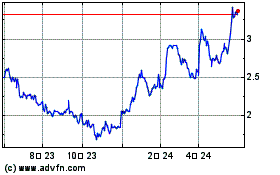0001447028 False 0001447028 2024-11-15 2024-11-15 iso4217:USD xbrli:shares iso4217:USD xbrli:shares
UNITED STATES
SECURITIES AND EXCHANGE COMMISSION
Washington, D.C. 20549
_________________
FORM 8-K
_________________
CURRENT REPORT
Pursuant to Section 13 or 15(d)
of the Securities Exchange Act of 1934
Date of Report (Date of earliest event reported): November 15, 2024
_______________________________
Arbutus Biopharma Corporation
(Exact name of registrant as specified in its charter)
_______________________________
| British Columbia, Canada | 001-34949 | 98-0597776 |
| (State or Other Jurisdiction of Incorporation) | (Commission File Number) | (I.R.S. Employer Identification No.) |
701 Veterans Circle
Warminster, Pennsylvania 18974
(Address of Principal Executive Offices) (Zip Code)
(267) 469-0914
(Registrant's telephone number, including area code)
(Former name or former address, if changed since last report)
_______________________________
Check the appropriate box below if the Form 8-K filing is intended to simultaneously satisfy the filing obligation of the registrant under any of the following provisions:
| ☐ | Written communications pursuant to Rule 425 under the Securities Act (17 CFR 230.425) |
| ☐ | Soliciting material pursuant to Rule 14a-12 under the Exchange Act (17 CFR 240.14a-12) |
| ☐ | Pre-commencement communications pursuant to Rule 14d-2(b) under the Exchange Act (17 CFR 240.14d-2(b)) |
| ☐ | Pre-commencement communications pursuant to Rule 13e-4(c) under the Exchange Act (17 CFR 240.13e-4(c)) |
Securities registered pursuant to Section 12(b) of the Act:
| Title of each class | Trading Symbol(s) | Name of each exchange on which registered |
| Common Shares, without par value | ABUS | The Nasdaq Stock Market LLC |
Indicate by check mark whether the registrant is an emerging growth company as defined in Rule 405 of the Securities Act of 1933 (§230.405 of this chapter) or Rule 12b-2 of the Securities Exchange Act of 1934 (§240.12b-2 of this chapter).
Emerging growth company ☐
If an emerging growth company, indicate by check mark if the registrant has elected not to use the extended transition period for complying with any new or revised financial accounting standards provided pursuant to Section 13(a) of the Exchange Act. ☐
Item 8.01. Other Events.
On November 15, 2024, Arbutus Biopharma Corporation (“Arbutus” or the “Company”) issued a press release announcing new data from its IM-PROVE I Phase 2a clinical trial (AB-729-201) showing that six doses of imdusiran, the Company’s RNAi therapeutic candidate, and 24 weeks of pegylated interferon alfa-2α (IFN), a standard-of-care immunomodulator, added to ongoing nucleos(t)ide analogue (NA) therapy, led to a functional cure rate of 50% (3/6) in HBeAg-negative patients with baseline HBsAg levels less than 1000 IU/mL, and an overall functional cure rate of 25% (3/12). Patients with HBsAg levels less than 1000 IU/mL represent a significant portion of the cHBV population. These data will be presented as a late-breaker poster presentation on November 18, 2024 at The American Association for the Study of Liver Diseases (AASLD) – The Liver Meeting® 2024. A copy of the press release is filed herewith as Exhibit 99.1 and is incorporated by reference herein.
On November 15, 2024, Arbutus and Barinthus Biotherapeutics plc, issued a press release announcing new preliminary data from the Phase 2a IM-PROVE II clinical trial (AB-729-202) of people with chronic hepatitis B virus (cHBV) at the American Association for the Study of Liver Diseases (AASLD) – The Liver Meeting® 2024. A copy of the press release is filed herewith as Exhibit 99.2 and is incorporated by reference herein.
On November 15, 2024, the Company posted an updated corporate presentation on its website at www.arbutusbio.com. A copy of the presentation is filed herewith as Exhibit 99.3 and is incorporated by reference herein.
Item 9.01. Financial Statements and Exhibits.
SIGNATURE
Pursuant to the requirements of the Securities Exchange Act of 1934, the registrant has duly caused this report to be signed on its behalf by the undersigned hereunto duly authorized.
| | Arbutus Biopharma Corporation |
| | | |
| | | |
| Date: November 15, 2024 | By: | /s/ David C. Hastings |
| | | David C. Hastings |
| | | Chief Financial Officer |
| | | |
EXHIBIT 99.1
Arbutus’ Imdusiran Achieves Functional Cure in cHBV Patients when Combined with a Short Course of Interferon
50% of patients who had baseline HBsAg levels less than 1000 IU/mL achieved functional cure in Cohort A1 of the IM-PROVE I Phase 2a clinical trial
Overall, in Cohort A1, 25% of patients achieved functional cure
Data to be presented in late-breaker poster session at AASLD – The Liver Meeting® on Monday, November 18, 2024
WARMINSTER, Pa., Nov. 15, 2024 (GLOBE NEWSWIRE) -- Arbutus Biopharma Corporation (Nasdaq: ABUS) (“Arbutus” or the “Company”), a clinical-stage biopharmaceutical company leveraging its extensive virology expertise to develop a functional cure for people with chronic hepatitis B virus (cHBV) infection, today announced new data from its IM-PROVE I Phase 2a clinical trial (AB-729-201) showing that six doses of imdusiran, the Company’s RNAi therapeutic candidate, and 24 weeks of pegylated interferon alfa-2α (IFN), a standard-of-care immunomodulator, added to ongoing nucleos(t)ide analogue (NA) therapy, led to a functional cure rate of 50% (3/6) in HBeAg-negative patients with baseline HBsAg levels less than 1000 IU/mL, and an overall functional cure rate of 25% (3/12). Patients with HBsAg levels less than 1000 IU/mL represent a significant portion of the cHBV population. These data will be presented as a late-breaker poster presentation on November 18, 2024 at The American Association for the Study of Liver Diseases (AASLD) – The Liver Meeting® 2024.
“For the first time, we are seeing a meaningful percentage of HBV patients functionally cured with an RNAi therapeutic and interferon,” commented Professor Man-Fung Yuen, D.Sc., M.D., Ph.D., Chief of the Division of Gastroenterology and Hepatology, the University of Hong Kong and Principal Investigator of the IM-PROVE I clinical trial, who will present the data at AASLD. “While 48 weeks of interferon can be used as a standard of care treatment for HBV patients, historically less than 10% of patients experience a functional cure. Here, with the combination of imdusiran and 24 weeks of interferon, we see a 50% functional cure rate in HBV patients with HBsAg less than 1000 IU/mL at baseline and a 25% functional cure rate overall. In addition, I was pleased to see that this regimen with a short course of interferon was generally safe and well-tolerated. These data are extremely impressive and provide hope for the millions of HBV patients worldwide and the medical community that a finite curative treatment is possible with imdusiran and interferon.”
Key data from patients in Cohort A1 that received 6 doses of imdusiran plus 24 weeks of IFN in addition to ongoing NA therapy include:
- 50% of patients (3/6) with baseline HBsAg <1000 IU/mL achieved a functional cure (defined as sustained HBsAg loss and HBV DNA less than the lower limit of quantification (LLOQ) 24 weeks off all treatment (including NAs), with or without hepatitis B surface antibodies (anti-HBs)).
- Overall, 25% of patients (3/12) achieved a functional cure.
- Those patients that achieved a functional cure also seroconverted with anti-HBs levels increasing as patients lost HBsAg.
- The combination of imdusiran and IFN was generally safe and well-tolerated. There were no serious adverse events (SAEs) related to imdusiran or IFN, and no adverse events (AEs) leading to discontinuation.
The late-breaker poster, titled, “IM-PROVE I: Imdusiran in Combination with Short Courses of Pegylated Interferon Alfa-2a in Virally Suppressed, HBeAg Negative Subjects with Chronic HBV (cHBV) Infection Leads to Functional Cure”, is available on the Company’s website and provides the complete data set for all four cohorts of patients dosed in this clinical trial.
Additional immune activation data in those patients in Cohort A1 that achieved a functional cure will be presented by Dr. Emily Thi, Senior Director, Immunobiology and Biomarkers Research at Arbutus Biopharma in a poster titled, “Soluble Immune Biomarker Profiling of Chronic Hepatitis B Subjects Treated with Imdusiran in Combination with Pegylated Interferon Alfa Reveals Phases of Immune Activation.” The data in this poster show that patients in Cohort A1 had greater increases in favorable immune biomarkers than those in other cohorts. Functionally cured patients and those with baseline HBsAg <1000 IU/mL had elevations of key immune biomarkers during the imdusiran lead-in, IFN treatment and follow-up periods, suggesting immune activation induced by imdusiran plus IFN treatment.
“We are extremely excited to have functionally cured these patients with the imdusiran and interferon treatment regimen. There is a significant need for a functional cure for the more than 250 million patients chronically infected with HBV worldwide,” commented Dr. Karen Sims, Chief Medical Officer of Arbutus Biopharma. “Excess production of surface antigen is believed to contribute to host immune exhaustion, resulting in inadequate immune response and failure to suppress the virus. These data support our belief that lowering surface antigen with imdusiran and incorporating an immunomodulator in the treatment regimen provides a functional cure in some patients with cHBV. We thank all the patients and investigators who participated in this clinical trial.”
All of the above posters that will be presented at AASLD – The Liver Meeting can be accessed through the Arbutus website under Publications.
IM-PROVE I CLINICAL TRIAL DETAILS
The IM-PROVE I Phase 2a Clinical trial (AB-729-201; NCT04980482) enrolled 43 HBeAg-negative, NA-suppressed patients with cHBV infection. After a 24-week lead-in with imdusiran (60 mg every 8 weeks, 4 doses) added to ongoing NA therapy, patients were randomized into one of the following four cohorts: Cohort A1: imdusiran (2 doses) + NA + IFN weekly for 24 weeks (n=12), Cohort A2: NA + IFN weekly for 24 weeks (n=13), Cohort B1: Imdusiran (1 dose) + NA + IFN weekly for 12 weeks (n=8) and Cohort B2: NA + IFN weekly for 12 weeks (n=10).
After completion of the IFN treatment period (Week 52 for cohorts A1 and A2 and Week 40 for cohorts B1 and B2), patients underwent a 24-week follow-up period on NA therapy alone and were then assessed for discontinuation of NA therapy. Patients with ALT levels less than two times the upper limit of normal, undetectable HBV DNA, and HBsAg <100 IU/mL at two consecutive visits at least 24 weeks after the last dose of imdusiran qualified to discontinue all therapy and will be followed for at least 48 weeks.
About Imdusiran (AB-729)
Imdusiran is an RNA interference (RNAi) therapeutic specifically designed to reduce all HBV viral proteins and antigens including hepatitis B surface antigen, which is thought to be a key prerequisite to enable reawakening of a patient’s immune system to respond to the virus. Imdusiran targets hepatocytes using Arbutus’ novel covalently conjugated N-Acetylgalactosamine (GalNAc) delivery technology enabling subcutaneous delivery. In a Phase 2a clinical trial, imdusiran achieved meaningful functional cure rates in patients with cHBV when combined with pegylated interferon alfa-2α and nucleos(t)ide analogue therapy. Additional clinical data generated thus far has shown imdusiran to be generally safe and well-tolerated, while also providing meaningful reductions in hepatitis B surface antigen and hepatitis B DNA. Plans are underway to advance imdusiran into a Phase 2b clinical trial.
About HBV
Hepatitis B is a potentially life-threatening liver infection caused by the hepatitis B virus (HBV). HBV can cause chronic infection which leads to a higher risk of death from cirrhosis and liver cancer. Chronic HBV infection represents a significant unmet medical need. The World Health Organization estimates that over 250 million people worldwide suffer from chronic HBV infection, while other estimates indicate that approximately 2 million people in the United States suffer from chronic HBV infection. Approximately 1.1 million people die every year from complications related to chronic HBV infection despite the availability of effective vaccines and current treatment options.
About Arbutus
Arbutus Biopharma Corporation (Nasdaq: ABUS) is a clinical-stage biopharmaceutical company leveraging its extensive virology expertise to develop novel therapeutics with distinct mechanisms of action, which can potentially be combined to provide a functional cure for patients with chronic hepatitis B virus (cHBV). Arbutus believes the key to success in developing a functional cure involves suppressing HBV DNA, reducing surface antigen, and boosting HBV-specific immune responses. Arbutus’ pipeline of internally developed, proprietary compounds includes an RNAi therapeutic, imdusiran (AB-729), and an oral PD-L1 inhibitor, AB-101. Imdusiran has achieved meaningful functional cure rates in patients with cHBV when administered as combination therapy. Plans are underway to advance imdusiran into a Phase 2b clinical trial. AB-101 is currently being evaluated in a Phase 1a/1b clinical trial. For more information, visit www.arbutusbio.com.
Forward-Looking Statements and Information
This press release contains forward-looking statements within the meaning of the Section 27A of the Securities Act of 1933 and Section 21E of the Securities Exchange Act of 1934, and forward-looking information within the meaning of Canadian securities laws (collectively, forward-looking statements). Forward-looking statements in this press release include statements about: the IM-PROVE I Phase 2a clinical trial data; the potential for finite curative treatment to be possible with imdusiran, interferon and NA therapy; the IM-PROVE I Phase 2a clinical trial data supporting Arbutus’ belief that lowering surface antigen with imdusiran and incorporating an immunomodulator in the treatment regimen combined with ongoing NA therapy provides a functional cure in some patients with cHBV; the potential to lead to a functional cure for HBV; Arbutus’ future development plans for its product candidates; the expected results of Arbutus’ clinical development plans and clinical trials with respect to its product candidates; Arbutus’ expectations with respect to the release of data from its clinical trials and the expected timing thereof; and the potential for Arbutus’ product candidates to achieve success in clinical trials.
With respect to the forward-looking statements contained in this press release, Arbutus has made numerous assumptions regarding, among other things: the effectiveness and timeliness of preclinical studies and clinical trials, and the usefulness of the data; the timeliness of regulatory approvals; the continued demand for Arbutus’ assets; and the stability of economic and market conditions. While Arbutus considers these assumptions to be reasonable, these assumptions are inherently subject to significant business, economic, competitive, market and social uncertainties and contingencies.
Additionally, there are known and unknown risk factors which could cause Arbutus’ actual results, performance or achievements to be materially different from any future results, performance or achievements expressed or implied by the forward-looking statements contained herein. Known risk factors include, among others: anticipated pre-clinical studies and clinical trials may be more costly or take longer to complete than anticipated, and may never be initiated or completed, or may not generate results that warrant future development of the tested product candidate; Arbutus may elect to change its strategy regarding its product candidates and clinical development activities; Arbutus may not receive the necessary regulatory approvals for the clinical development of Arbutus’ products; economic and market conditions may worsen; market shifts may require a change in strategic focus.
A more complete discussion of the risks and uncertainties facing Arbutus appears in Arbutus’ Annual Report on Form 10-K, Arbutus’ Quarterly Reports on Form 10-Q and Arbutus’ continuous and periodic disclosure filings, which are available at www.sedar.com and at www.sec.gov. All forward-looking statements herein are qualified in their entirety by this cautionary statement, and Arbutus disclaims any obligation to revise or update any such forward-looking statements or to publicly announce the result of any revisions to any of the forward-looking statements contained herein to reflect future results, events or developments, except as required by law.
Contact Information
Investors and Media
Lisa M. Caperelli
Vice President, Investor Relations
Phone: 215-206-1822
Email: lcaperelli@arbutusbio.com
EXHIBIT 99.2
Arbutus and Barinthus Bio Announce New Data from the IM-PROVE II Trial Showing that the Addition of Nivolumab Increased Rates of HBsAg Loss in People with Chronic Hepatitis B
Significantly greater mean declines in HBsAg levels (p <0.017) were seen in those receiving imdusiran, VTP-300 and low-dose nivolumab compared to other cohorts assessed previously
23% of participants receiving imdusiran, VTP-300 and low-dose nivolumab reached HBsAg loss by Week 48
WARMINSTER, Pa. and OXFORD, United Kingdom, Nov. 15, 2024 (GLOBE NEWSWIRE) -- Arbutus Biopharma Corporation (Nasdaq: ABUS), (“Arbutus” or the “Company”) a clinical-stage biopharmaceutical company leveraging its extensive virology expertise to develop a functional cure for people with chronic hepatitis B virus infection, and Barinthus Biotherapeutics plc (NASDAQ: BRNS), a clinical-stage biopharmaceutical company developing novel immunotherapeutic candidates that guide T cells to control disease, today announced new preliminary data from the Phase 2a IM-PROVE II clinical trial (AB-729-202) of people with chronic hepatitis B virus (cHBV) at the American Association for the Study of Liver Diseases (AASLD) – The Liver Meeting® 2024.
The new data are from an additional cohort of participants (Group C) who received repeat doses of imdusiran, Arbutus’ RNAi therapeutic, followed by Barinthus Bio's T-cell stimulating immunotherapeutic, VTP-300, with or without low-dose nivolumab, an anti-PD-1 monoclonal antibody. The data indicated that Group C participants receiving nivolumab experienced increased rates of HBsAg loss (defined as HBsAg <LLOQ [0.05 IU/mL]) compared to Group A and B participants who received imdusiran and VTP-300 or placebo. The data from Groups A and B were previously presented at the European Association for the Study of the Liver (EASL) Congress in June 2024.
Group C enrolled a total of 22 non-cirrhotic, virally suppressed cHBV participants with HBsAg ≥100 to <5,000 IU/mL at screening who were on stable nucleos(t)ide analogue (NUC) therapy for ≥12 months. Thirteen of these participants were eligible to receive low-dose nivolumab and nine participants were not eligible, based on the trial criteria.
The preliminary data from Group C included data to Week 48 (20/22 participants) and showed the following:
- Imdusiran lead-in treatment led to a mean decline from baseline in HBsAg consistent with data from Groups A and B.
- Significantly greater mean declines in HBsAg levels (p <0.017) were seen in Group C participants who received imdusiran and VTP-300 with nivolumab, at Week 48 compared with Groups A and B and Group C without nivolumab.
- 23% of participants (3/13) in the group receiving imdusiran, VTP-300 and low-dose nivolumab achieved HBsAg loss by Week 48.
- Increases in soluble immune biomarkers associated with immune checkpoint proteins, inflammation, and T-cell activation were observed in participants who had HBsAg loss at any point through Week 48.
- The Group C treatment regimen with nivolumab was generally well tolerated and did not result in any immune-related adverse events.
“These data demonstrated the impact of the combination of an immune stimulant such as VTP-300 and a low dose of the checkpoint inhibitor nivolumab in helping participants reach HBsAg loss,” said Dr. Leon Hooftman, Chief Medical Officer of Barinthus Bio. “While these are early data, the imdusiran, VTP-300 and low-dose nivolumab regimen is promising and is consistent with the data we are seeing from our HBV003 trial of VTP-300 plus low-dose nivolumab.”
“These data continue to support our belief that lowering surface antigen is key to promoting HBV-specific immune reawakening,” commented Dr. Karen Sims, Chief Medical Officer of Arbutus Biopharma. “In this trial, imdusiran provided meaningful reductions in HBsAg prior to treatment with the immunomodulatory agents VTP-300 and low dose nivolumab, leading to improved response rates with this combination.”
The poster from the presentation at AASLD 2024 can be accessed through the Arbutus website under Publications.
IM-PROVE II Trial Details
The IM-PROVE II Phase 2a clinical trial initially enrolled 40 non-cirrhotic, virally suppressed cHBV participants that were on stable NUC therapy in Groups A and B. These participants received imdusiran (60mg every 8 weeks) for 24 weeks with on-going NUC therapy and were then randomized to receive either VTP-300 (Group A) or placebo (Group B) at Weeks 26 and 30 (and conditionally at Week 38 if they experienced a >0.5 log10 decline in HBsAg between Weeks 26 and 34).
This trial was amended to include an additional cohort (Group C) which enrolled 22 participants, 13 of which were eligible to receive imdusiran (60mg every 8 weeks) for 24 weeks with ongoing NUC therapy followed by VTP-300 at Weeks 26 and 30 plus up to two low doses of nivolumab (0.3 mg/kg), an approved PD-1 monoclonal antibody at Week 30. The remaining 9 participants received the imdusiran/NUC/VTP-300 regimen without nivolumab. Participants could receive a second dose of VTP-300 ± low-dose nivolumab at Week 38 if their HBsAg was ≥10 IU/mL at Week 34.
Upon completion of the treatment period at Week 48, all participants who met certain criteria could discontinue NUC therapy and be followed for an additional 48 weeks. Those who did not meet the criteria continued on NUC therapy for an additional 24 weeks of follow-up.
About Imdusiran (AB-729)
Imdusiran is an RNA interference (RNAi) therapeutic specifically designed to reduce all HBV viral proteins and antigens including hepatitis B surface antigen, which is thought to be a key prerequisite to enable reawakening of a patient’s immune system to respond to the virus. Imdusiran targets hepatocytes using Arbutus’ novel covalently conjugated N-Acetylgalactosamine (GalNAc) delivery technology enabling subcutaneous delivery. Clinical data generated thus far has shown single and multiple doses of imdusiran to be generally safe and well-tolerated, while also providing meaningful reductions in hepatitis B surface antigen and hepatitis B DNA. Imdusiran is currently in multiple Phase 2a clinical trials.
About VTP-300
VTP-300 is an immunotherapeutic candidate consisting of an initial dose using the ChAdOx vector and a secondary dose(s) using the MVA vector, both encoding multiple HBsAg, including full-length surface, modified polymerase, and core antigens. VTP-300 is the first antigen-specific immunotherapy that has been shown to induce sustained reductions in HBsAg. Barinthus Bio is studying VTP-300 in combination with other agents, including siRNA and low-dose anti-PD-1 antibodies, to control the infection, and counterbalance the immune suppression and T cell exhaustion in the liver caused by chronic HBV infection.
About Arbutus
Arbutus Biopharma Corporation (Nasdaq: ABUS) is a clinical-stage biopharmaceutical company leveraging its extensive virology expertise to develop novel therapeutics with distinct mechanisms of action, which can potentially be combined to provide a functional cure for patients with chronic hepatitis B virus (cHBV). Arbutus believes the key to success in developing a functional cure involves suppressing HBV DNA, reducing surface antigen, and boosting HBV-specific immune responses. Arbutus’ pipeline of internally developed, proprietary compounds includes an RNAi therapeutic, imdusiran (AB-729), and an oral PD-L1 inhibitor, AB-101. Imdusiran has generated meaningful clinical data demonstrating an impact on both surface antigen reduction and reawakening of the HBV-specific immune response. Imdusiran is currently in two Phase 2a combination clinical trials. AB-101 is currently being evaluated in a Phase 1a/1b clinical trial. For more information, visit www.arbutusbio.com.
About Barinthus Bio
Barinthus Biotherapeutics (Nasdaq: BRNS) is a clinical-stage biopharmaceutical company developing novel immunotherapeutic candidates designed to guide the immune system to overcome chronic infectious diseases and autoimmunity. Helping people living with serious diseases and their families is the guiding principle at the heart of Barinthus Bio. With a focused pipeline built around its proprietary platform technologies, Barinthus Bio is advancing immunotherapeutic product candidates in infectious diseases and autoimmunity, including: VTP-300, that utilizing its ChAdOx/MVA platform designed as a potential component of a functional cure for chronic HBV infection and VTP-1000, utilizing our SNAP-Tolerance Immunotherapy (SNAP-TI) platform and is designed to treat people with celiac disease. Barinthus Bio is also conducting a Phase 1 clinical trial for VTP-850, a second-generation immunotherapeutic candidate designed to treat recurrent prostate cancer. Barinthus Bio’s differentiated technology platforms and therapeutic approach, coupled with deep scientific expertise and focus on clinical development, uniquely positions the company to navigate towards delivering treatments that improve the lives of people with chronic infectious diseases and autoimmunity. For more information, visit www.barinthusbio.com.
Arbutus Forward Looking Statements and Information
This press release contains forward-looking statements within the meaning of the Section 27A of the Securities Act of 1933 and Section 21E of the Securities Exchange Act of 1934, and forward-looking information within the meaning of Canadian securities laws (collectively, forward-looking statements). Forward-looking statements in this press release include statements about Arbutus’ future development plans for its product candidates; the expected cost, timing and results of its clinical development plans and clinical trials with respect to Arbutus’ product candidates; Arbutus’ expectations with respect to the release of data from its clinical trials and the expected timing thereof; Arbutus’ expectations and goals for its collaborations with third parties and any potential benefits related thereto; and the potential for Arbutus’ product candidates to achieve success in clinical trials.
With respect to the forward-looking statements contained in this press release, Arbutus has made numerous assumptions regarding, among other things: the effectiveness and timeliness of preclinical studies and clinical trials, and the usefulness of the data; the timeliness of regulatory approvals; the continued demand for Arbutus’ assets; and the stability of economic and market conditions. While Arbutus considers these assumptions to be reasonable, these assumptions are inherently subject to significant business, economic, competitive, market and social uncertainties and contingencies, including uncertainties and contingencies related to patent litigation matters.
Additionally, there are known and unknown risk factors which could cause Arbutus’ actual results, performance or achievements to be materially different from any future results, performance or achievements expressed or implied by the forward-looking statements contained herein. Known risk factors include, among others: anticipated pre-clinical studies and clinical trials may be more costly or take longer to complete than anticipated, and may never be initiated or completed, or may not generate results that warrant future development of the tested product candidate; Arbutus may elect to change its strategy regarding its product candidates and clinical development activities; Arbutus may not receive the necessary regulatory approvals for the clinical development of Arbutus’ products; economic and market conditions may worsen; Arbutus may not realize the anticipated benefits from its recent organizational changes; Arbutus may incur additional unexpected expenses in connection with the organizational changes; Arbutus may experience additional employee turnover as a result of the organizational changes; uncertainties associated with litigation generally and patent litigation specifically; and Arbutus and its collaborators may never realize the expected benefits of the collaborations; and market shifts may require a change in strategic focus.
A more complete discussion of the risks and uncertainties facing Arbutus appears in Arbutus’ Annual Report on Form 10-K, Arbutus’ Quarterly Reports on Form 10-Q and Arbutus’ continuous and periodic disclosure filings, which are available at www.sedar.com and at www.sec.gov. All forward-looking statements herein are qualified in their entirety by this cautionary statement, and Arbutus disclaims any obligation to revise or update any such forward-looking statements or to publicly announce the result of any revisions to any of the forward-looking statements contained herein to reflect future results, events or developments, except as required by law.
Barinthus Bio’s Forward Looking Statements
This press release contains forward-looking statements regarding Barinthus Bio within the meaning of the Private Securities Litigation Reform Act of 1995, as amended, which can generally be identified as such by use of the words “may,” “will,” “plan,” “forward,” “encouraging,” “believe,” “potential,” “expect,” and similar expressions, although not all forward-looking statements contain these identifying words. These forward-looking statements include, without limitation, express or implied statements regarding our future expectations, plans and prospects, including our product development activities and clinical trials, including timing for readouts of any preliminary, interim or final data or next steps for any of our programs, and our ability to develop and advance our current and future product candidates and programs. Any forward-looking statements in this press release are based on our management’s current expectations and beliefs and are subject to numerous risks, uncertainties and important factors that may cause actual events or results to differ materially from those expressed or implied by any forward-looking statements contained in this press release, including, without limitation, risks and uncertainties related to the success, cost and timing of our pipeline development activities and planned and ongoing clinical trials, including the risk that the timing for preliminary, interim or final data or initiation of our clinical trials may be delayed, the risk that interim or topline data may not reflect final data or results, our ability to execute on our strategy, regulatory developments, the risk that we may not achieve the anticipated benefits of our pipeline prioritization and corporate restructuring, our ability to fund our operations and access capital, our cash runway, including the risk that our estimate of our cash runway may be incorrect, global economic uncertainty, including disruptions in the banking industry, the conflicts in Ukraine, Israel and Gaza, and other risks identified in our filings with the Securities and Exchange Commission, including our Annual Report on Form 10-K for the year ended December 31, 2023, our Quarterly Reports on Form 10-Q and Current Reports on Form 8-K. We caution you not to place undue reliance on any forward-looking statements, which speak only as of the date they are made. We expressly disclaim any obligation to publicly update or revise any such statements to reflect any change in expectations or in events, conditions or circumstances on which any such statements may be based, or that may affect the likelihood that actual results will differ from those set forth in the forward-looking statements.
Arbutus Biopharma Contacts:
Investor & Media Contact:
Lisa M. Caperelli
Vice President, Investor Relations
1-215-206-1822
lcaperelli@arbutusbio.com
Barinthus Bio Contacts:
IR contacts:
Christopher M. Calabrese
Managing Director
LifeSci Advisors
+1 917-680-5608
ccalabrese@lifesciadvisors.com
Kevin Gardner
Managing Director
LifeSci Advisors
+1 617-283-2856
kgardner@lifesciadvisors.com
Media contact:
Audra Friis
Sam Brown, Inc.
+1 917-519-9577
audrafriis@sambrown.com
Company contact:
Jonothan Blackbourn
IR & PR Manager
Barinthus Bio
ir@barinthusbio.com
EXHIBIT 99.3

NASDAQ: ABUS www.arbutusbio.com November 15, 2024 Corporate Presentation © 2024 Arbutus Biopharma, Inc.
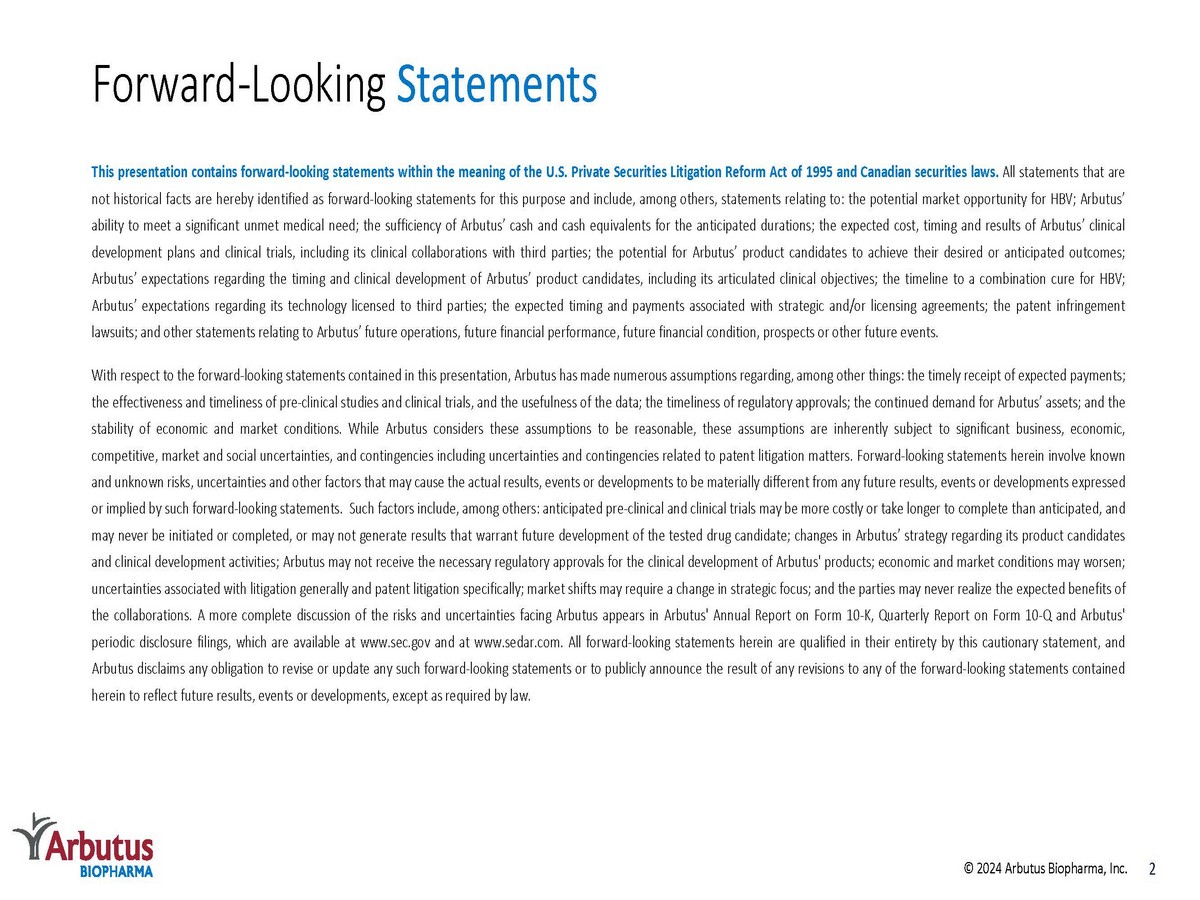
Forward - Looking Statements This presentation contains forward - looking statements within the meaning of the U . S . Private Securities Litigation Reform Act of 1995 and Canadian securities laws . All statements that are not historical facts are hereby identified as forward - looking statements for this purpose and include, among others, statements relating to : the potential market opportunity for HBV ; Arbutus’ ability to meet a significant unmet medical need ; the sufficiency of Arbutus’ cash and cash equivalents for the anticipated durations ; the expected cost, timing and results of Arbutus’ clinical development plans and clinical trials, including its clinical collaborations with third parties ; the potential for Arbutus’ product candidates to achieve their desired or anticipated outcomes ; Arbutus’ expectations regarding the timing and clinical development of Arbutus’ product candidates, including its articulated clinical objectives ; the timeline to a combination cure for HBV ; Arbutus’ expectations regarding its technology licensed to third parties ; the expected timing and payments associated with strategic and/or licensing agreements ; the patent infringement lawsuits ; and other statements relating to Arbutus’ future operations, future financial performance, future financial condition, prospects or other future events . With respect to the forward - looking statements contained in this presentation, Arbutus has made numerous assumptions regarding, among other things : the timely receipt of expected payments ; the effectiveness and timeliness of pre - clinical studies and clinical trials, and the usefulness of the data ; the timeliness of regulatory approvals ; the continued demand for Arbutus’ assets ; and the stability of economic and market conditions . While Arbutus considers these assumptions to be reasonable, these assumptions are inherently subject to significant business, economic, competitive, market and social uncertainties, and contingencies including uncertainties and contingencies related to patent litigation matters . Forward - looking statements herein involve known and unknown risks, uncertainties and other factors that may cause the actual results, events or developments to be materially different from any future results, events or developments expressed or implied by such forward - looking statements . Such factors include, among others : anticipated pre - clinical and clinical trials may be more costly or take longer to complete than anticipated, and may never be initiated or completed, or may not generate results that warrant future development of the tested drug candidate ; changes in Arbutus’ strategy regarding its product candidates and clinical development activities ; Arbutus may not receive the necessary regulatory approvals for the clinical development of Arbutus' products ; economic and market conditions may worsen ; uncertainties associated with litigation generally and patent litigation specifically ; market shifts may require a change in strategic focus ; and the parties may never realize the expected benefits of the collaborations . A more complete discussion of the risks and uncertainties facing Arbutus appears in Arbutus' Annual Report on Form 10 - K, Quarterly Report on Form 10 - Q and Arbutus' periodic disclosure filings, which are available at www . sec . gov and at www . sedar . com . All forward - looking statements herein are qualified in their entirety by this cautionary statement, and Arbutus disclaims any obligation to revise or update any such forward - looking statements or to publicly announce the result of any revisions to any of the forward - looking statements contained herein to reflect future results, events or developments, except as required by law . 2 © 2024 Arbutus Biopharma, Inc.
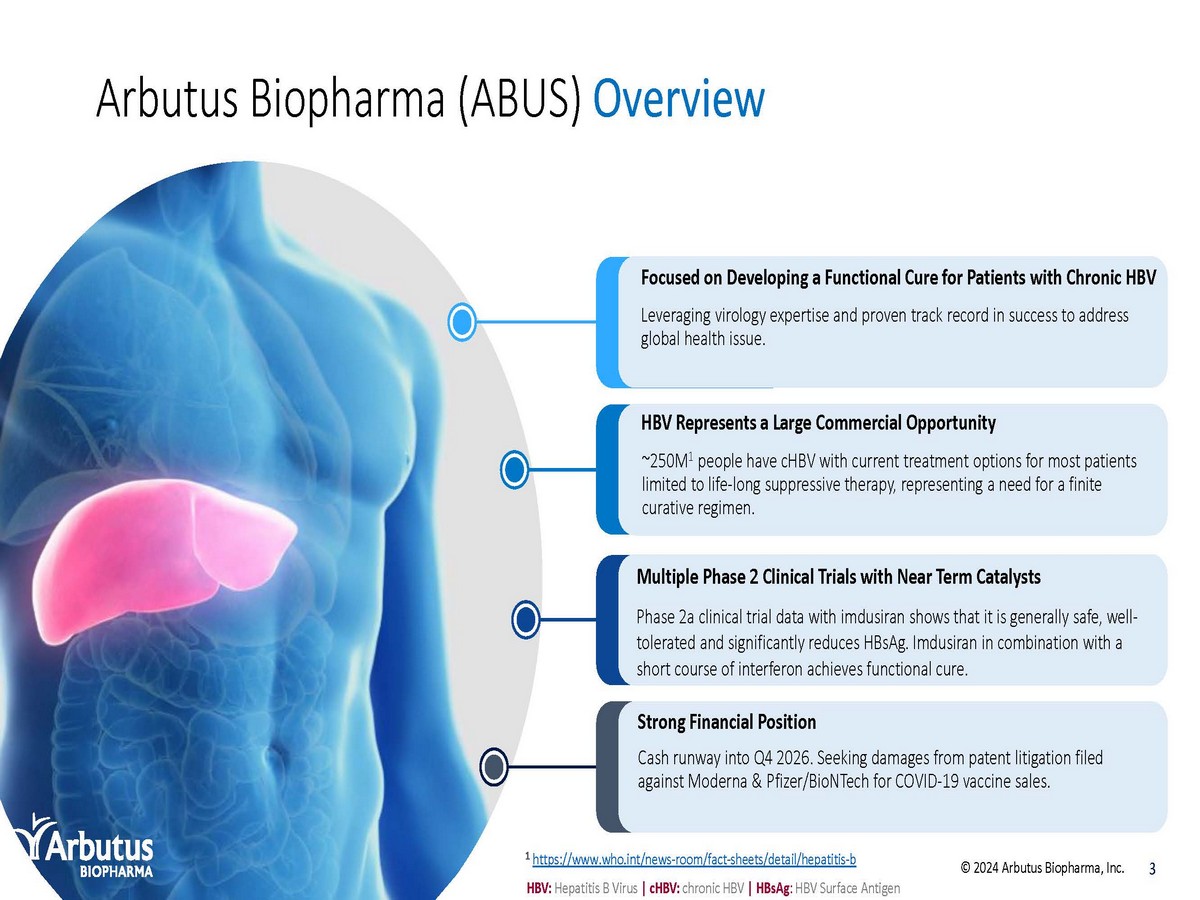
Arbutus Biopharma (ABUS) Overview ~250M 1 people have cHBV with current treatment options for most patients limited to life - long suppressive therapy, representing a need for a finite curative regimen. HBV Represents a Large Commercial Opportunity ` Phase 2a clinical trial data with imdusiran shows that it is generally safe, well - tolerated and significantly reduces HBsAg. Imdusiran in combination with a short course of interferon achieves functional cure. Multiple Phase 2 Clinical Trials with Near Term Catalysts Cash runway into Q4 2026. Seeking damages from patent litigation filed against Moderna & Pfizer/BioNTech for COVID - 19 vaccine sales. Strong Financial Position Leveraging virology expertise and proven track record in success to address global health issue. Focused on Developing a Functional Cure for Patients with Chronic HBV HBV: Hepatitis B Virus | cHBV : chronic HBV | HBsAg : HBV Surface Antigen 3 © 2024 Arbutus Biopharma, Inc. 1 https://www.who.int/news - room/fact - sheets/detail/hepatitis - b
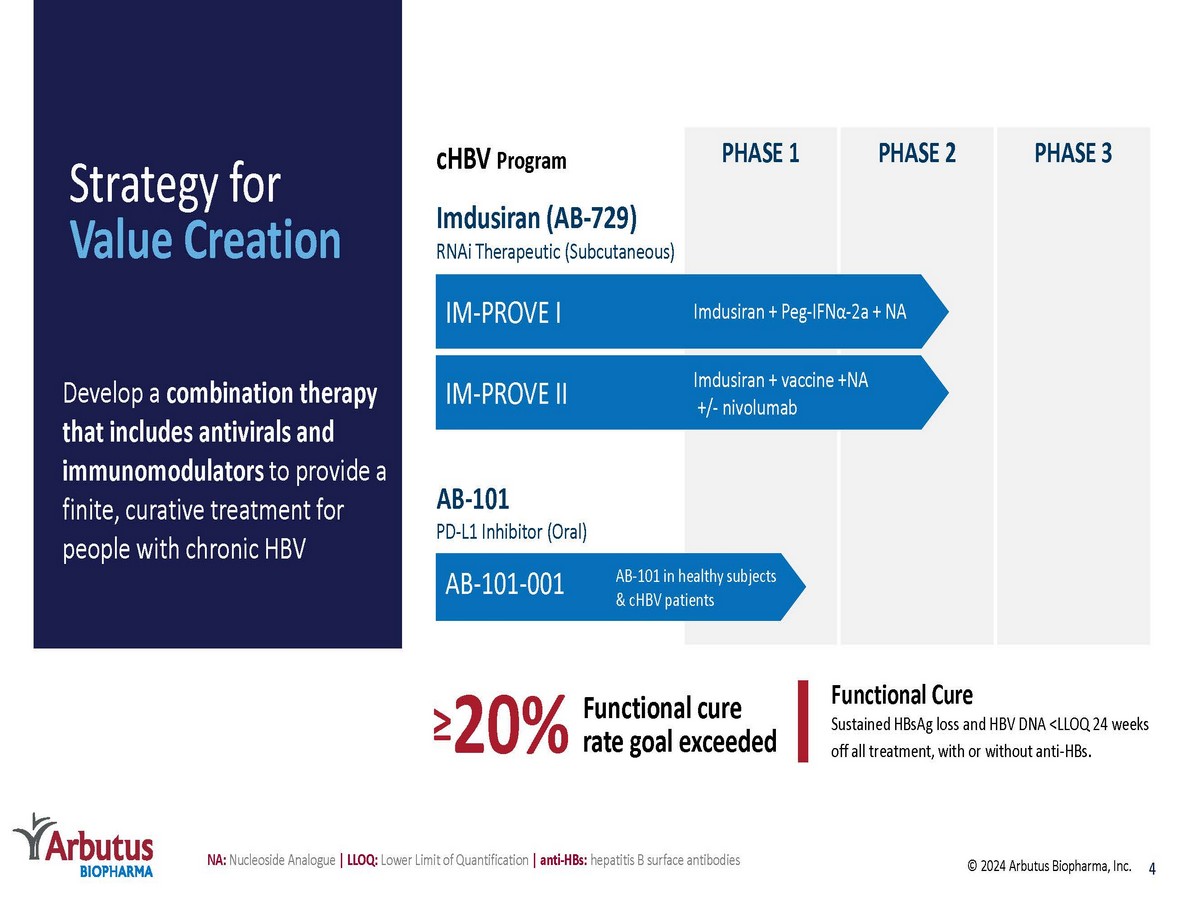
PHASE 1 PHASE 2 PHASE 3 Strategy for Value Creation Develop a combination therapy that includes antivirals and immunomodulators to provide a finite, curative treatment for people with chronic HBV Imdusiran (AB - 729) RNAi Therapeutic (Subcutaneous) AB - 101 PD - L1 Inhibitor (Oral) cHBV Program AB - 101 in healthy subjects & cHBV patients AB - 101 - 001 IM - PROVE I IM - PROVE II Functional cure rate goal exceeded Functional Cure Sustained HBsAg loss and HBV DNA <LLOQ 24 weeks off all treatment, with or without anti - HBs . ≥ 20% NA: Nucleoside Analogue | LLOQ : Lower Limit of Quantification | anti - HBs : hepatitis B surface antibodies 4 © 2024 Arbutus Biopharma, Inc. Imdusiran + Peg - IFN α - 2a + NA Imdusiran + vaccine +NA +/ - nivolumab
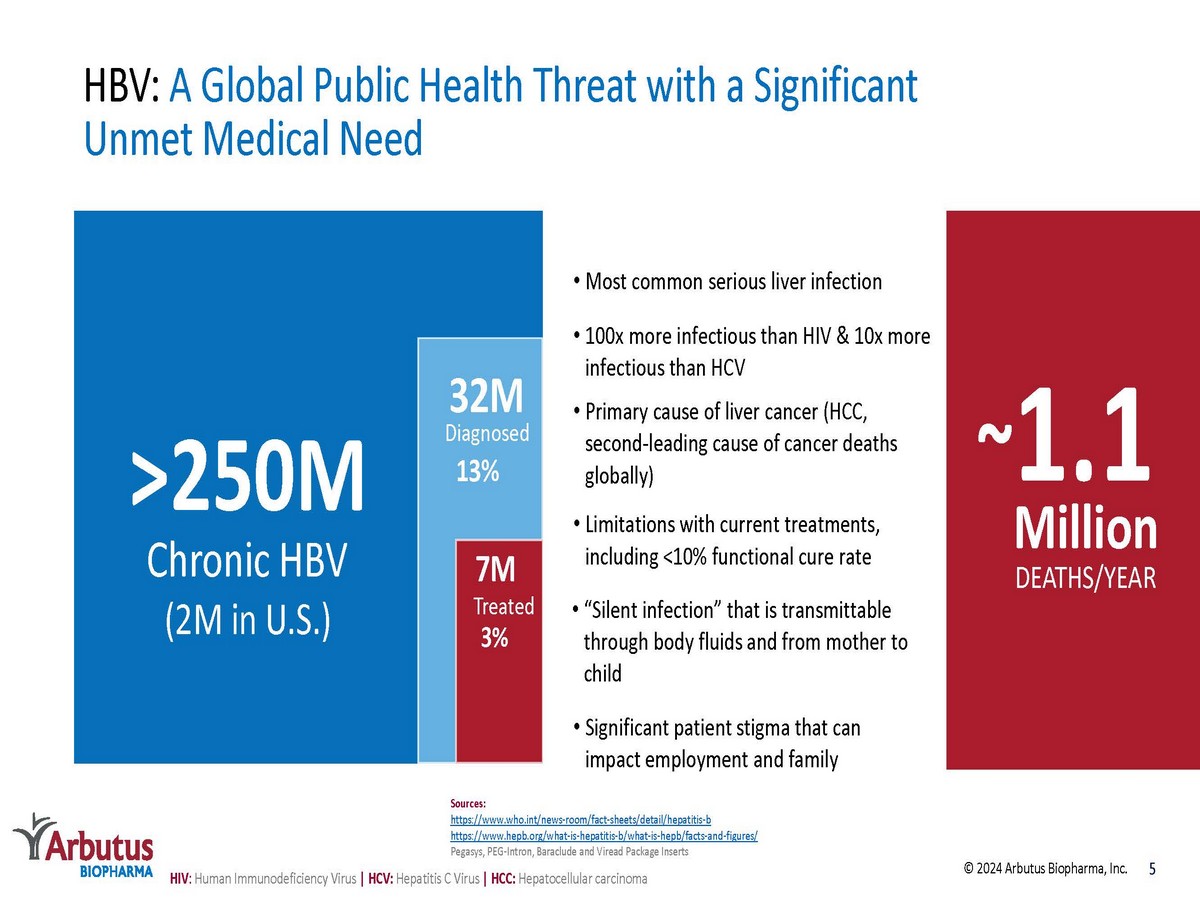
Chronic HBV (2M in U.S.) >250M HBV: A Global Public Health Threat with a Significant Unmet Medical Need Treated 7M 3% Diagnosed 32M 13% Sources: https://www.who.int/news - room/fact - sheets/detail/hepatitis - b https://www.hepb.org/what - is - hepatitis - b/what - is - hepb/facts - and - figures/ Pegasys , PEG - Intron, Baraclude and Viread Package Inserts 5 © 2024 Arbutus Biopharma, Inc. HIV : Human Immunodeficiency Virus | HCV: Hepatitis C Virus | HCC: Hepatocellular carcinoma • Most common serious liver infection • 100x more infectious than HIV & 10x more infectious than HCV • Primary cause of liver cancer (HCC, second - leading cause of cancer deaths globally ) • Limitations with current treatments, including <10% functional cure rate • “Silent infection” that is transmittable through body fluids and from mother to child • Significant patient stigma that can impact employment and family Million DEATHS/YEAR ~ 1.1
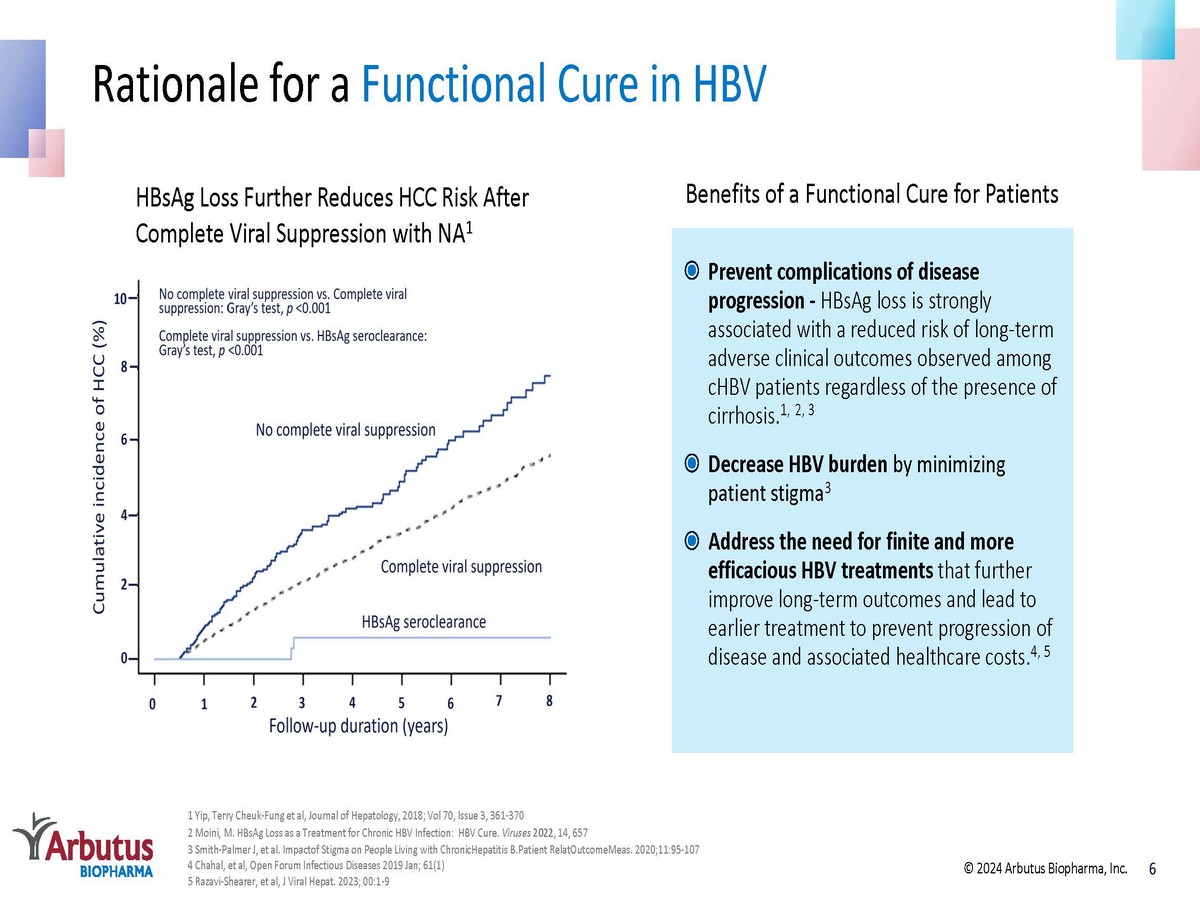
6 © 2024 Arbutus Biopharma, Inc. Rationale for a Functional Cure in HBV Prevent complications of disease progression - HBsAg loss is strongly associated with a reduced risk of long - term adverse clinical outcomes observed among cHBV patients regardless of the presence of cirrhosis. 1, 2, 3 Decrease HBV burden by minimizing patient stigma 3 Address the need for finite and more efficacious HBV treatments that further improve long - term outcomes and lead to earlier treatment to prevent progression of disease and associated healthcare costs. 4, 5 Benefits of a Functional Cure for Patients 1 Yip, Terry Cheuk - Fung et al, Journal of Hepatology, 2018; Vol 70, Issue 3, 361 - 370 2 Moini , M. HBsAg Loss as a Treatment for Chronic HBV Infection: HBV Cure. Viruses 2022 , 14, 657 3 Smith - Palmer J, et al. Impactof Stigma on People Living with ChronicHepatitis B.Patient RelatOutcomeMeas. 2020;11:95 - 107 4 Chahal, et al, Open Forum Infectious Diseases 2019 Jan; 61(1) 5 Razavi - Shearer, et al, J Viral Hepat. 2023; 00:1 - 9 HBsAg Loss Further Reduces HCC Risk After Complete Viral Suppression with NA 1
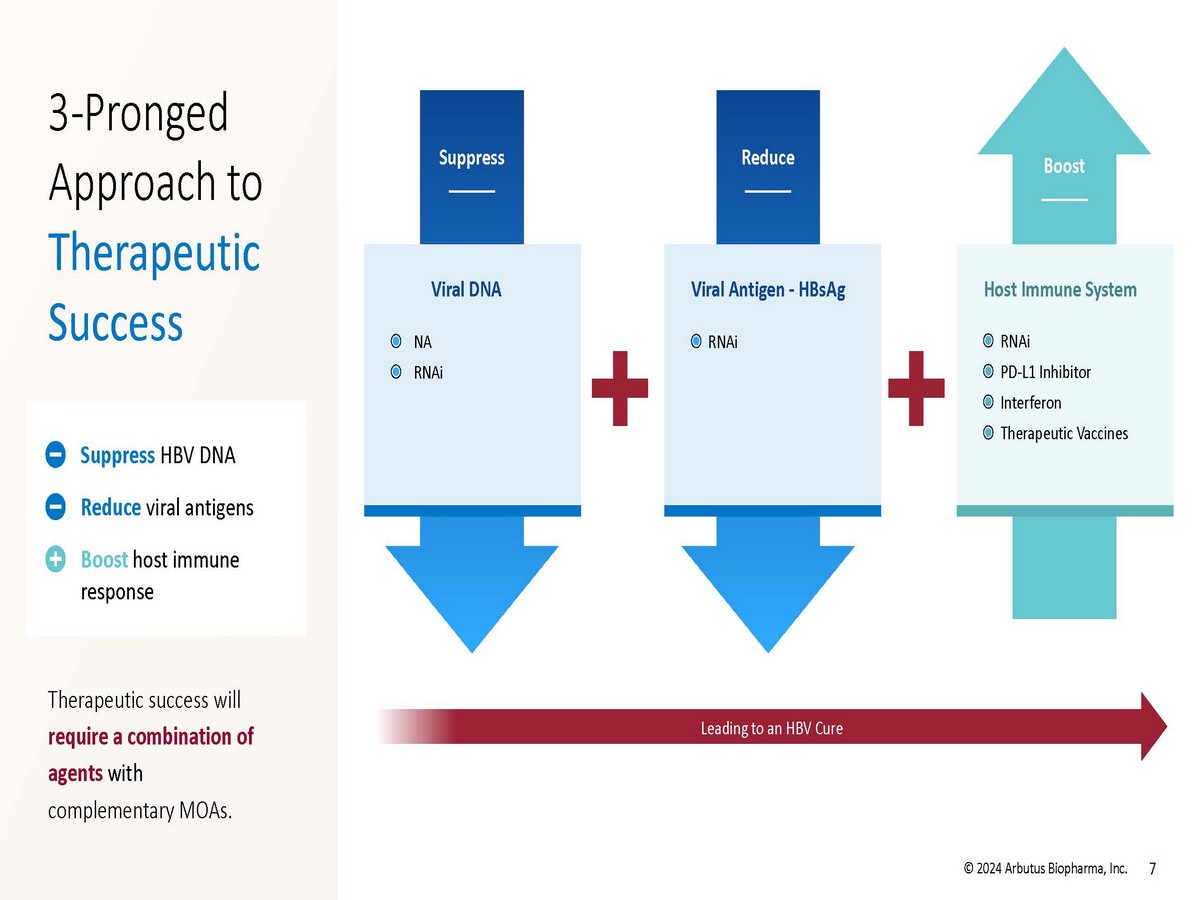
Suppress Reduce Boost Viral DNA Viral Antigen - HBsAg Host Immune System Leading to an HBV Cure 3 - Pronged Approach to Therapeutic Success Therapeutic success will require a combination of agents with complementary MOAs. Suppress HBV DNA Reduce viral antigens Boost host immune response 7 NA RNAi RNAi RNAi PD - L1 Inhibitor Interferon Therapeutic Vaccines © 2024 Arbutus Biopharma, Inc.
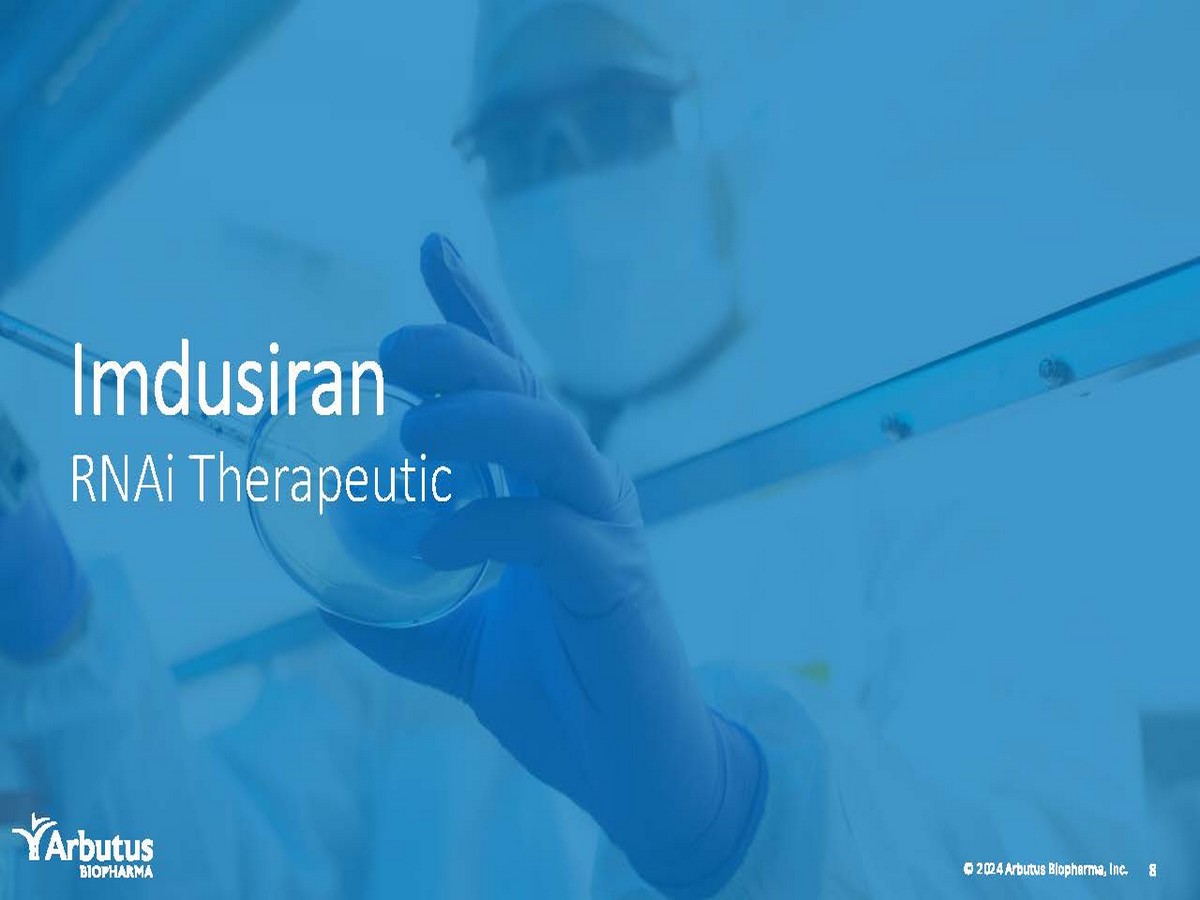
8 © 2024 Arbutus Biopharma, Inc. Imdusiran RNAi Therapeutic
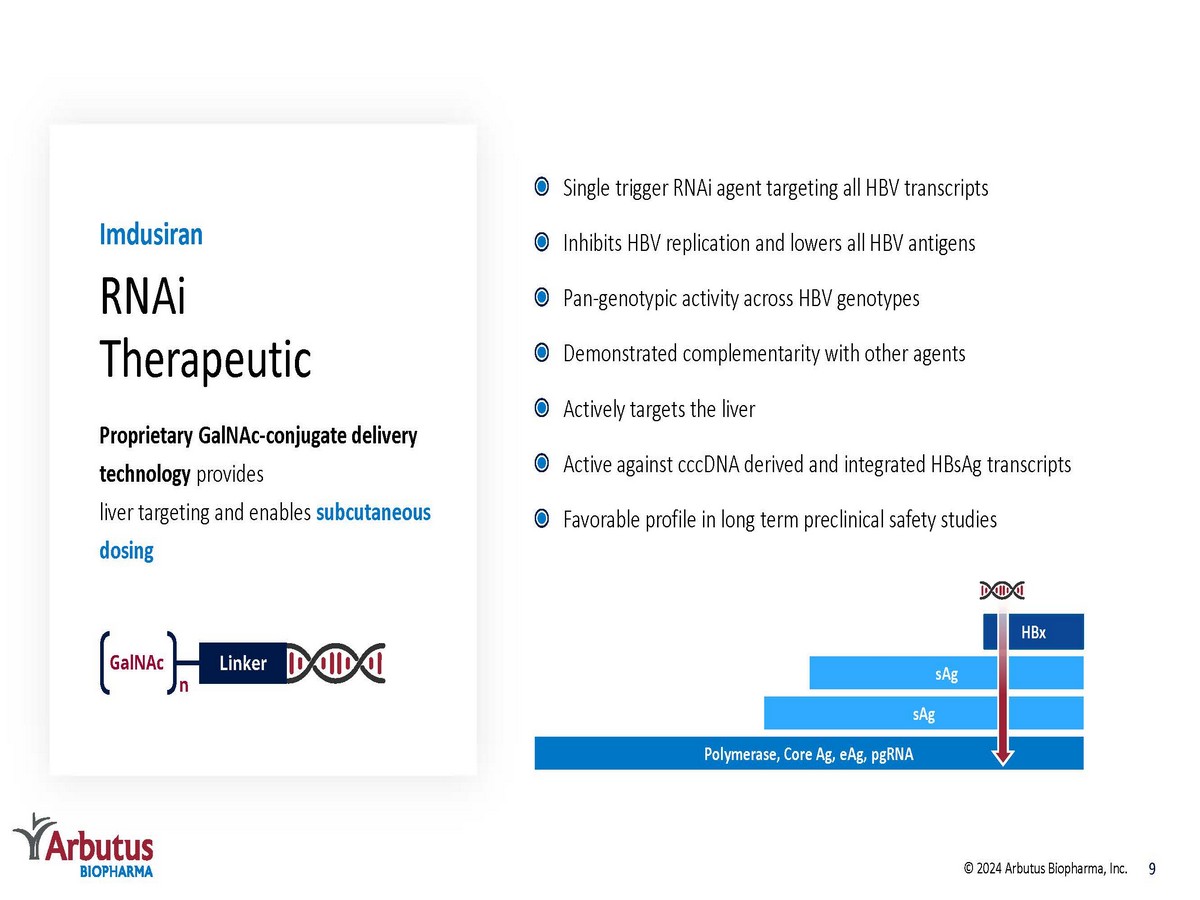
Proprietary GalNAc - conjugate delivery technology provides liver targeting and enables subcutaneous dosing Single trigger RNAi agent targeting all HBV transcripts Inhibits HBV replication and lowers all HBV antigens Pan - genotypic activity across HBV genotypes Demonstrated complementarity with other agents Actively targets the liver Active against cccDNA derived and integrated HBsAg transcripts Favorable profile in long term preclinical safety studies RNAi Therapeutic Imdusiran GalNAc n Linker Polymerase, Core Ag, eAg , pgRNA sAg sAg HBx 9 © 2024 Arbutus Biopharma, Inc.
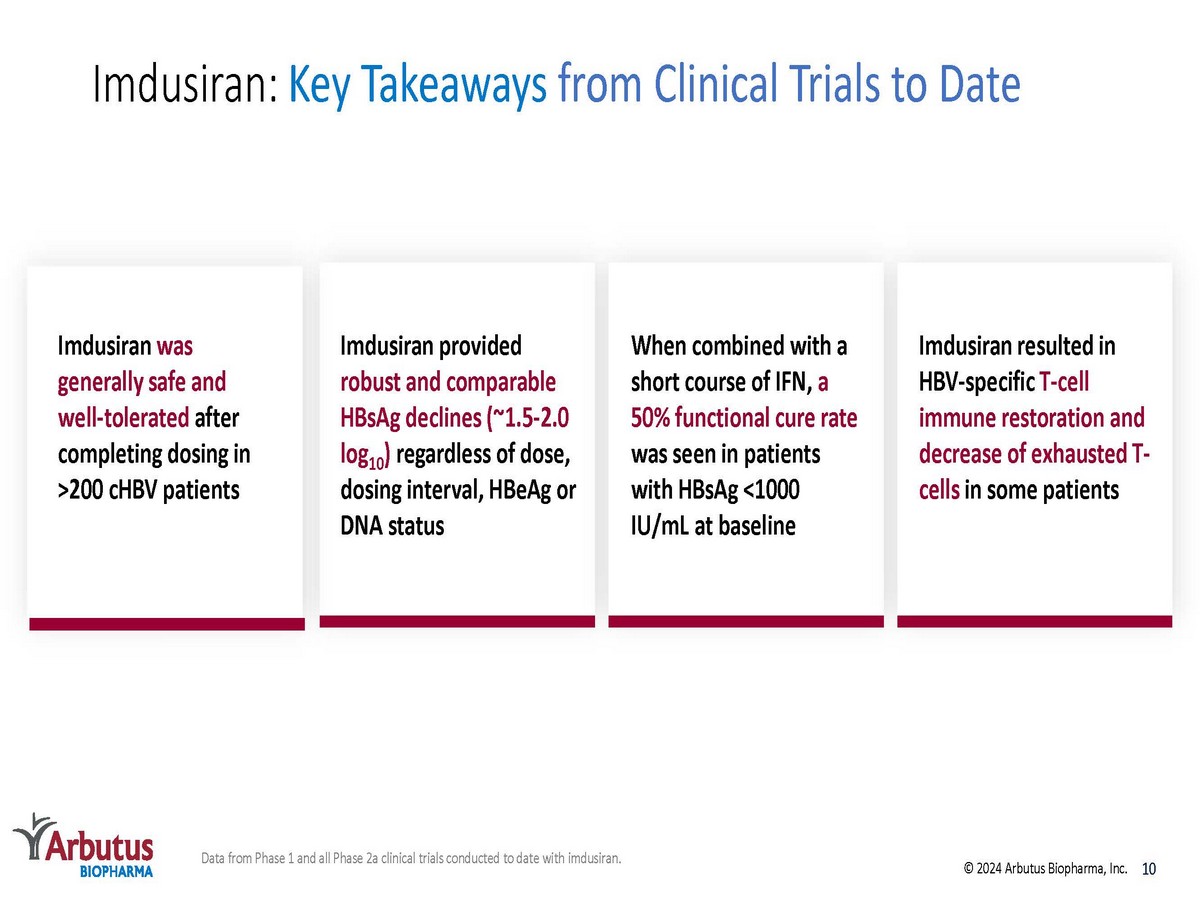
Imdusiran: Key Takeaways from Clinical Trials to Date Imdusiran provided robust and comparable HBsAg declines (~1.5 - 2.0 log 10 ) regardless of dose, dosing interval, HBeAg or DNA status When combined with a short course of IFN, a 50% functional cure rate was seen in patients with HBsAg <1000 IU/mL at baseline Imdusiran was generally safe and well - tolerated after completing dosing in >200 cHBV patients Imdusiran resulted in HBV - specific T - cell immune restoration and decrease of exhausted T - cells in some patients 10 © 2024 Arbutus Biopharma, Inc. Data from Phase 1 and all Phase 2a clinical trials conducted to date with imdusiran .
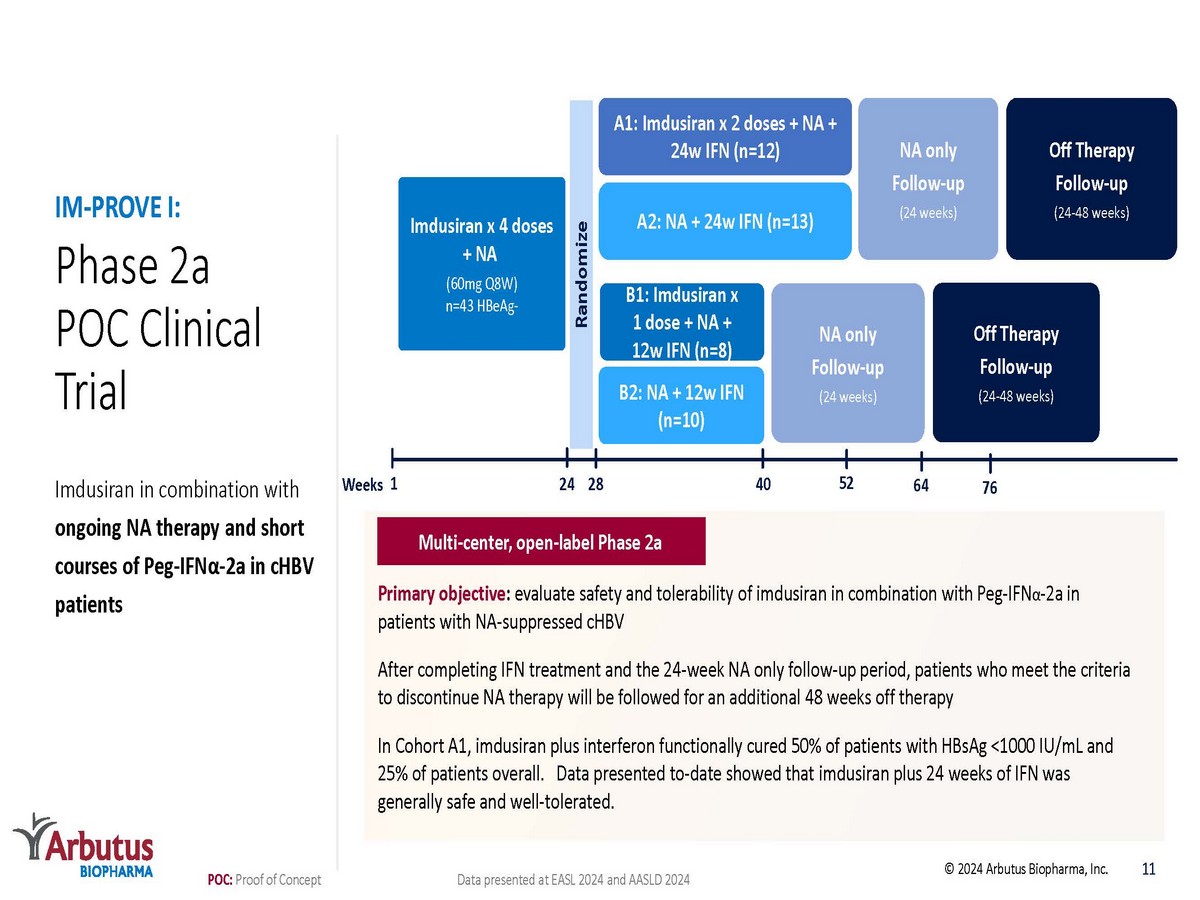
Phase 2a POC Clinical Trial Imdusiran in combination with ongoing NA therapy and short courses of Peg - IFN α - 2 a in cHBV patients IM - PROVE I: POC: Proof of Concept Primary objective : evaluate safety and tolerability of imdusiran in combination with Peg - IFN α - 2a in patients with NA - suppressed cHBV After completing IFN treatment and the 24 - week NA only follow - up period, patients who meet the criteria to discontinue NA therapy will be followed for an additional 48 weeks off therapy In Cohort A1, imdusiran plus interferon functionally cured 50% of patients with HBsAg <1000 IU/mL and 25% of patients overall. Data presented to - date showed that imdusiran plus 24 weeks of IFN was generally safe and well - tolerated. Multi - center, open - label Phase 2a 11 © 2024 Arbutus Biopharma, Inc. Weeks NA only Follow - up (24 weeks) A1: Imdusiran x 2 doses + NA + 24w IFN (n=12) A2: NA + 24w IFN (n=13) B1: Imdusiran x 1 dose + NA + 12w IFN (n=8) B2: NA + 12w IFN (n=10) Imdusiran x 4 doses + NA (60mg Q8W) n=43 HBeAg - Randomize NA only Follow - up (24 weeks) 1 52 28 24 40 Off Therapy Follow - up (24 - 48 weeks) Off Therapy Follow - up (24 - 48 weeks) 64 76 Data presented at EASL 2024 and AASLD 2024
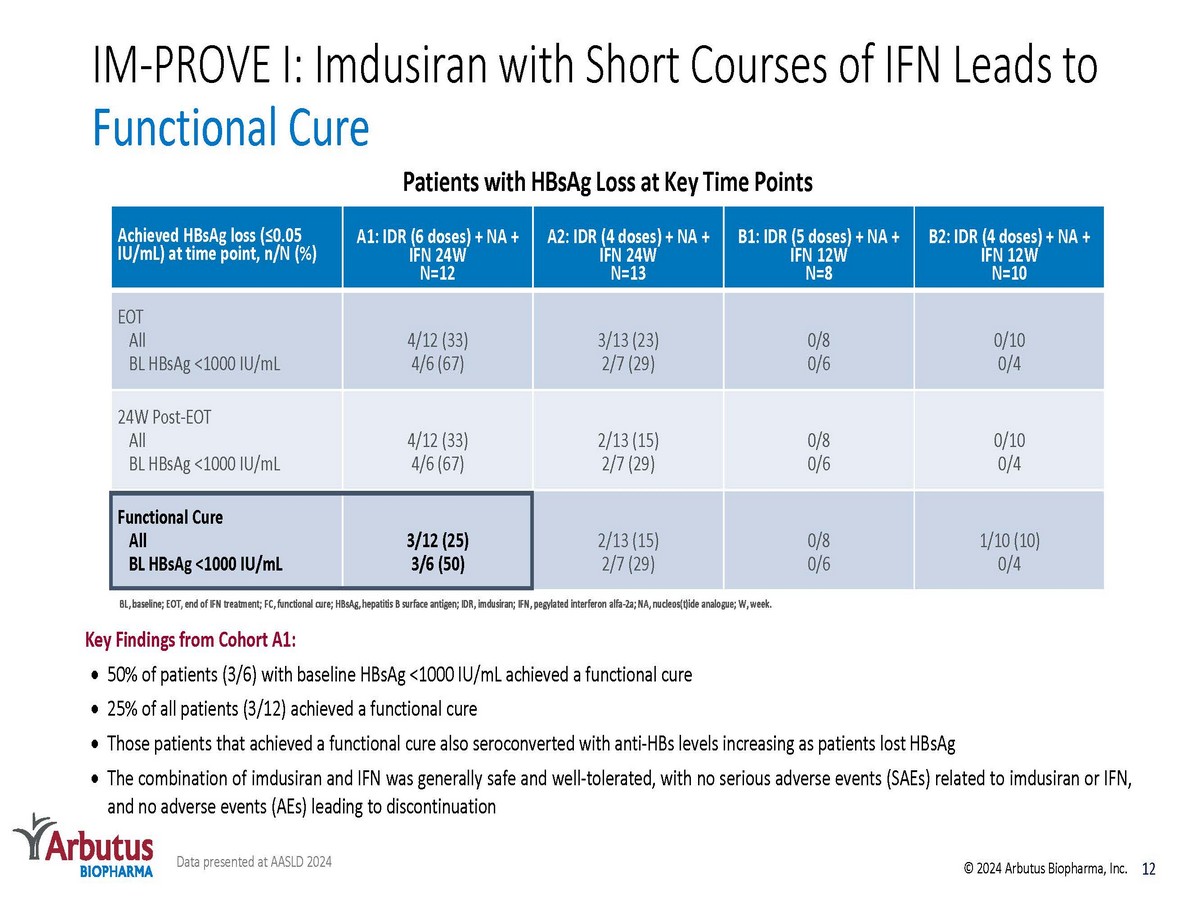
IM - PROVE I: Imdusiran with Short Courses of IFN Leads to Functional Cure Data presented at AASLD 2024 © 2024 Arbutus Biopharma, Inc. Patients with HBsAg Loss at Key Time Points B2: IDR (4 doses) + NA + IFN 12W N=10 B1: IDR (5 doses) + NA + IFN 12W N=8 A2: IDR (4 doses) + NA + IFN 24W N=13 A1: IDR (6 doses) + NA + IFN 24W N=12 Achieved HBsAg loss (≤0.05 IU/mL) at time point, n/N (%) 0/10 0/4 0/8 0/6 3/13 (23) 2/7 (29) 4/12 (33) 4/6 (67) EOT All BL HBsAg <1000 IU/mL 0/10 0/4 0/8 0/6 2/13 (15) 2/7 (29) 4/12 (33) 4/6 (67) 24W Post - EOT All BL HBsAg <1000 IU/mL 1/10 (10) 0/4 0/8 0/6 2/13 (15) 2/7 (29) 3/12 (25) 3/6 (50) Functional Cure All BL HBsAg <1000 IU/mL BL, baseline; EOT, end of IFN treatment; FC, functional cure; HBsAg, hepatitis B surface antigen; IDR, imdusiran ; IFN, pegylated interferon alfa - 2a; NA, nucleos (t)ide analogue; W, week. 12 Key Findings from Cohort A1: 50 % of patients ( 3 / 6 ) with baseline HBsAg < 1000 IU/mL achieved a functional cure 25 % of all patients ( 3 / 12 ) achieved a functional cure Those patients that achieved a functional cure also seroconverted with anti - HBs levels increasing as patients lost HBsAg The combination of imdusiran and IFN was generally safe and well - tolerated , with no serious adverse events (SAEs) related to imdusiran or IFN, and no adverse events (AEs) leading to discontinuation
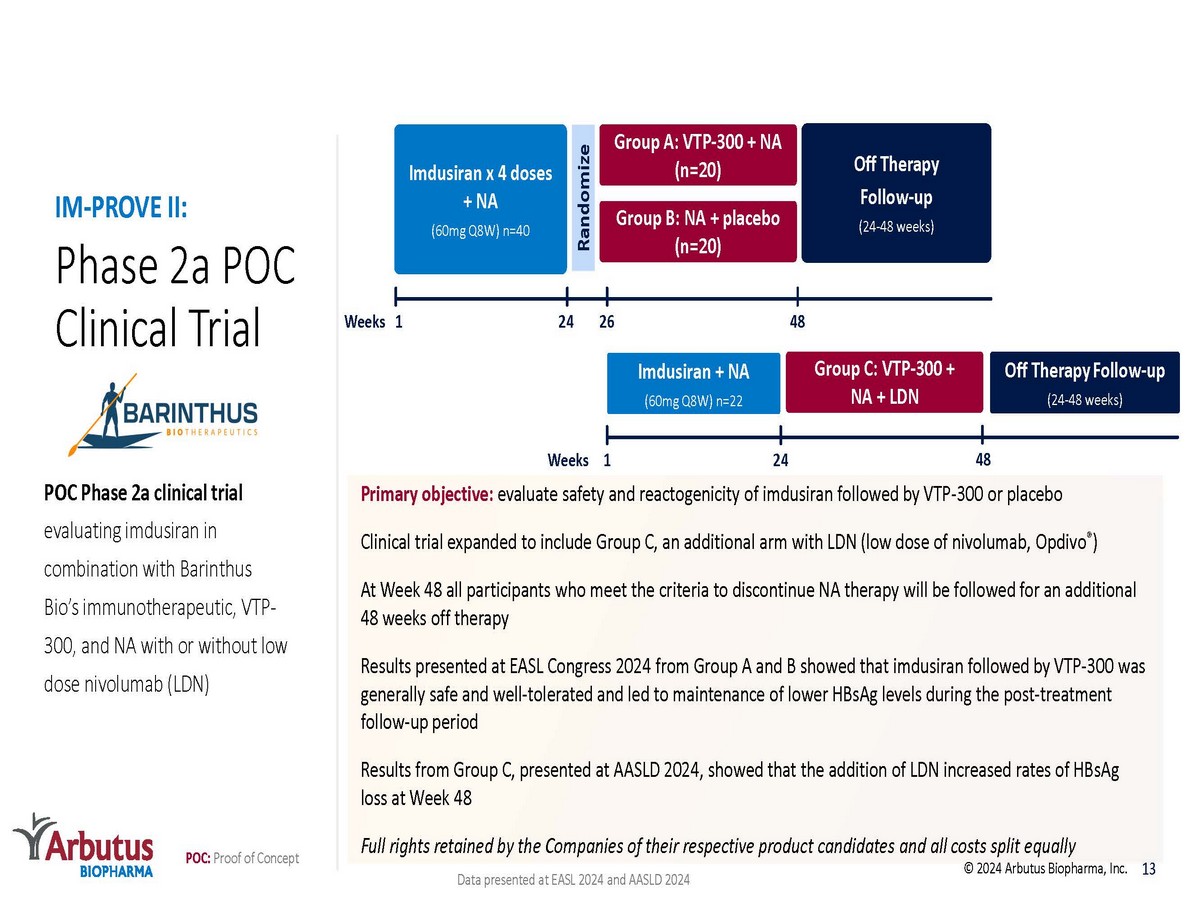
Phase 2a POC Clinical Trial POC Phase 2a clinical trial evaluating imdusiran in combination with Barinthus Bio’s immunotherapeutic, VTP - 300, and NA with or without low dose nivolumab (LDN) IM - PROVE II: Primary objective: evaluate safety and reactogenicity of imdusiran followed by VTP - 300 or placebo Clinical trial expanded to include Group C, an additional arm with LDN (low dose of nivolumab, Opdivo ® ) At Week 48 all participants who meet the criteria to discontinue NA therapy will be followed for an additional 48 weeks off therapy Results presented at EASL Congress 2024 from Group A and B showed that imdusiran followed by VTP - 300 was generally safe and well - tolerated and led to maintenance of lower HBsAg levels during the post - treatment follow - up period Results from Group C, presented at AASLD 2024, showed that the addition of LDN increased rates of HBsAg loss at Week 48 Full rights retained by the Companies of their respective product candidates and all costs split equally 13 Off Therapy Follow - up (24 - 48 weeks) Group A: VTP - 300 + NA (n=20) Group B: NA + placebo (n=20) 1 Imdusiran x 4 doses + NA (60mg Q8W) n=40 Randomize Weeks Imdusiran + NA (60mg Q8W) n=22 24 Group C: VTP - 300 + NA + LDN 1 48 26 24 Weeks 48 Off Therapy Follow - up (24 - 48 weeks) © 2024 Arbutus Biopharma, Inc. POC: Proof of Concept Data presented at EASL 2024 and AASLD 2024
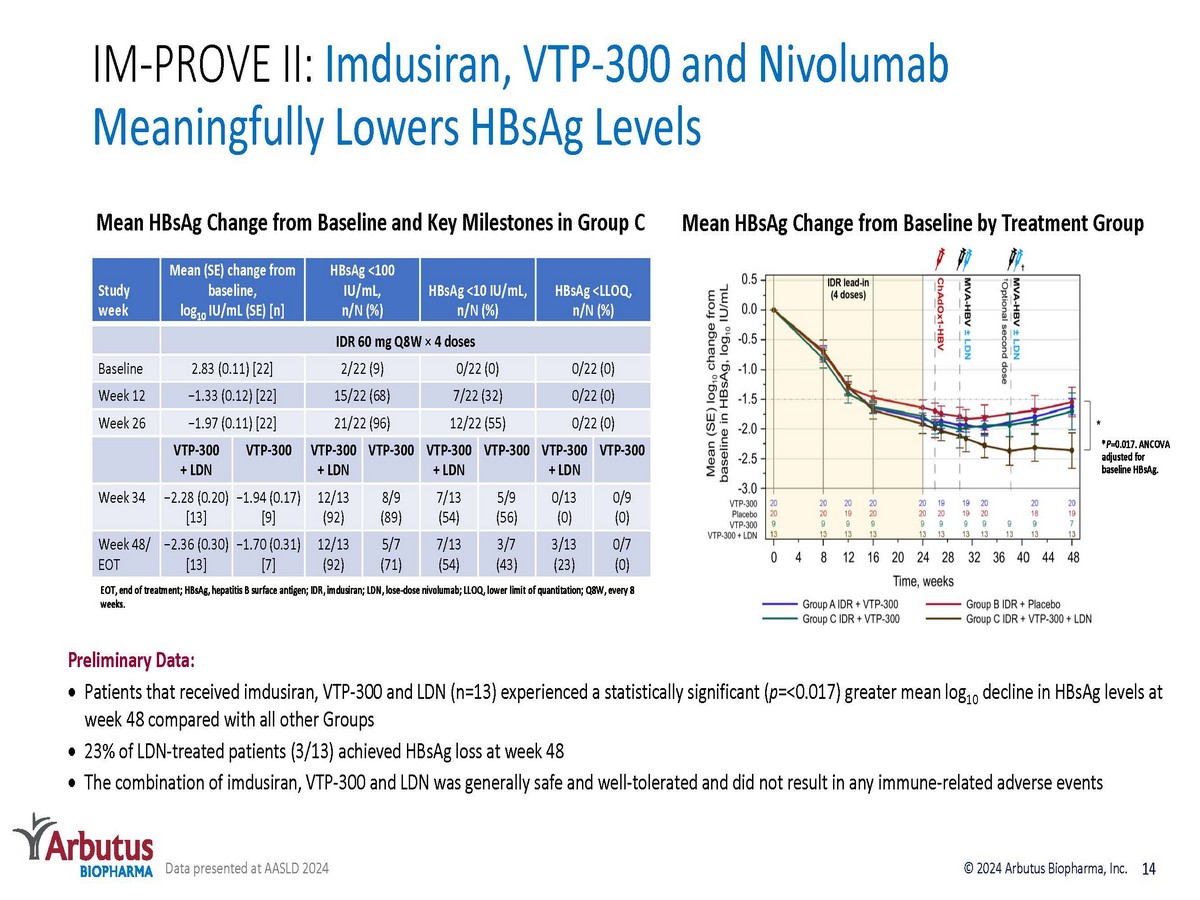
IM - PROVE II: Imdusiran, VTP - 300 and Nivolumab Meaningfully Lowers HBsAg Levels 14 © 2024 Arbutus Biopharma, Inc. Preliminary Data : Patients that received imdusiran, VTP - 300 and LDN (n= 13 ) experienced a statistically significant ( p =< 0 . 017 ) greater mean log 10 decline in HBsAg levels at week 48 compared with all other Groups 23 % of LDN - trea ted patients ( 3 / 13 ) achieved HBsAg loss at week 48 The combination of imdusiran, VTP - 300 and LDN was generally safe and well - tolerated and did not result in any immune - related adverse events Data presented at AASLD 2024 Mean HBsAg Change from Baseline and Key Milestones in Group C Mean HBsAg Change from Baseline by Treatment Group HBsAg <LLOQ, n/N (%) HBsAg <10 IU/mL, n/N (%) HBsAg <100 IU/mL, n/N (%) Mean (SE) change from baseline, log 10 IU/mL (SE) [n] Study week IDR 60 mg Q8W × 4 doses 0/22 (0) 0/22 (0) 2/22 (9) 2.83 (0.11) [22] Baseline 0/22 (0) 7/22 (32) 15/22 (68) −1.33 (0.12) [22] Week 12 0/22 (0) 12/22 (55) 21/22 (96) −1.97 (0.11) [22] Week 26 VTP - 300 VTP - 300 + LDN VTP - 300 VTP - 300 + LDN VTP - 300 VTP - 300 + LDN VTP - 300 VTP - 300 + LDN 0/9 (0) 0/13 (0) 5/9 (56) 7/13 (54) 8/9 (89) 12/13 (92) −1.94 (0.17) [9] −2.28 (0.20) [13] Week 34 0/7 (0) 3/13 (23) 3/7 (43) 7/13 (54) 5/7 (71) 12/13 (92) −1.70 (0.31) [7] −2.36 (0.30) [13] Week 48/ EOT EOT, end of treatment; HBsAg, hepatitis B surface antigen; IDR, imdusiran ; LDN, lose - dose nivolumab; LLOQ, lower limit of quantitation; Q8W, every 8 weeks. * P =0.017. ANCOVA adjusted for baseline HBsAg.
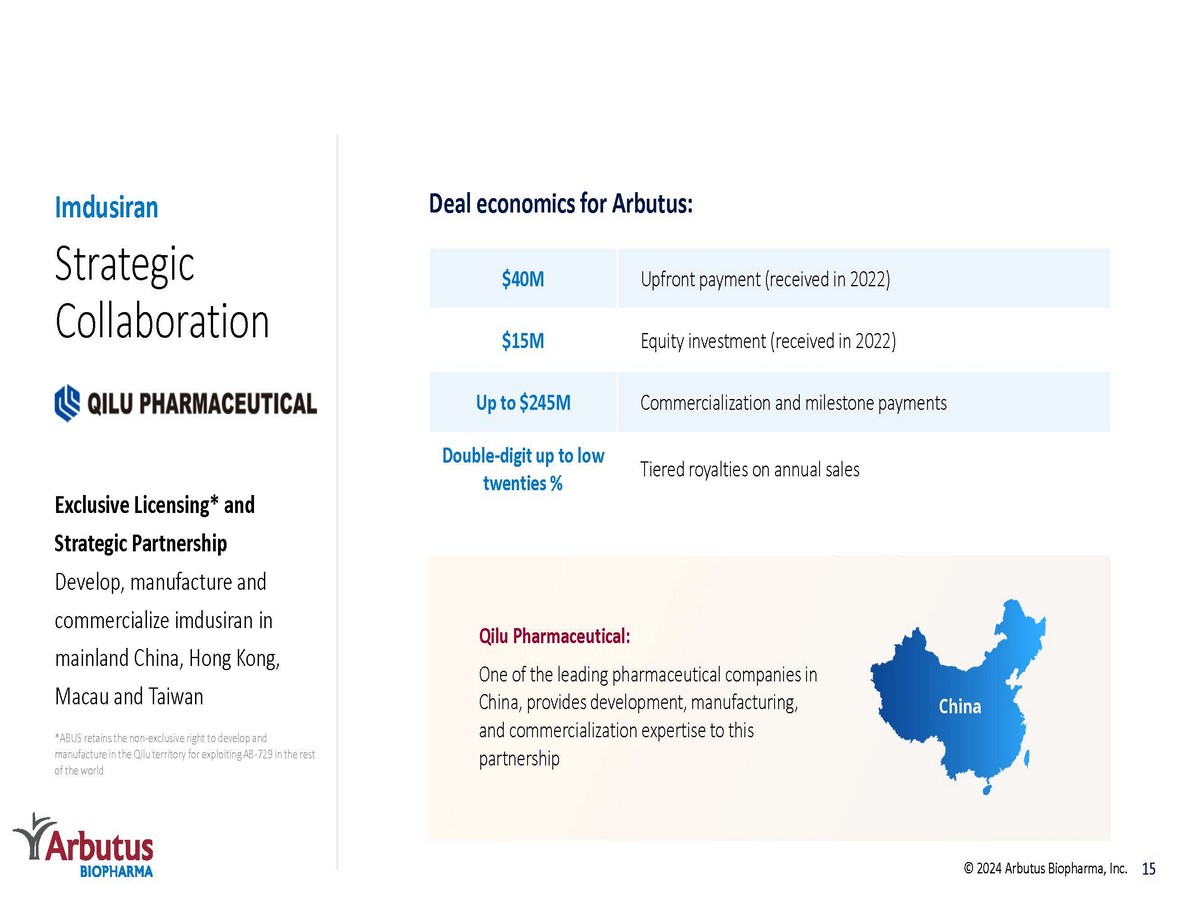
Strategic Collaboration Exclusive Licensing* and Strategic Partnership Develop, manufacture and commercialize imdusiran in mainland China, Hong Kong, Macau and Taiwan Imdusiran Upfront payment (received in 2022) $40M Equity investment (received in 2022) $15M Commercialization and milestone payments Up to $245M Tiered royalties on annual sales Double - digit up to low twenties % *ABUS retains the non - exclusive right to develop and manufacture in the Qilu territory for exploiting AB - 729 in the rest of the world Deal economics for Arbutus: Qilu Pharmaceutical: One of the leading pharmaceutical companies in China, provides development, manufacturing, and commercialization expertise to this partnership China 15 © 2024 Arbutus Biopharma, Inc.
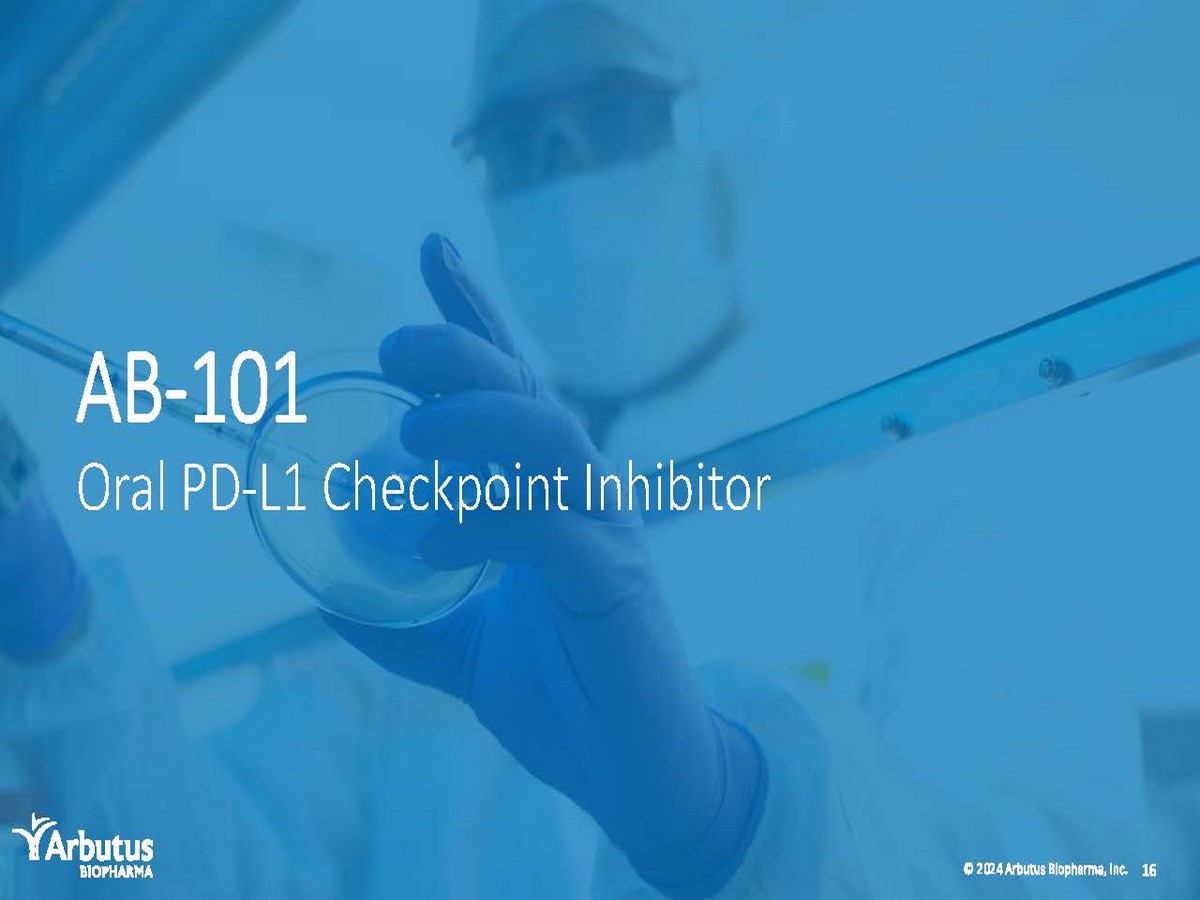
16 © 2024 Arbutus Biopharma, Inc. AB - 101 Oral PD - L1 Checkpoint Inhibitor
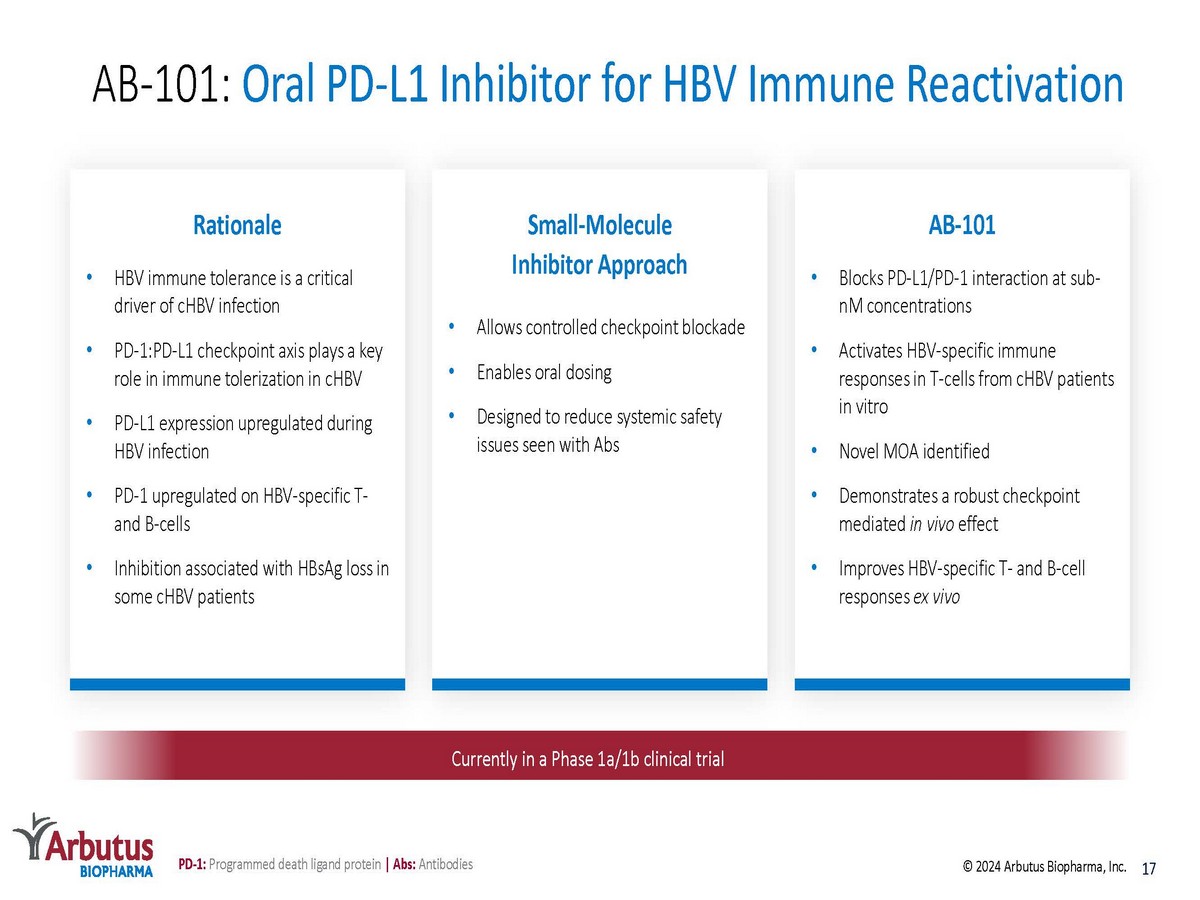
AB - 101: Oral PD - L1 Inhibitor for HBV Immune Reactivation PD - 1: Programmed death ligand protein | Abs: Antibodies Currently in a Phase 1a/1b clinical trial Rationale • HBV immune tolerance is a critical driver of cHBV infection • PD - 1:PD - L1 checkpoint axis plays a key role in immune tolerization in cHBV • PD - L1 expression upregulated during HBV infection • PD - 1 upregulated on HBV - specific T - and B - cells • Inhibition associated with HBsAg loss in some cHBV patients AB - 101 • Blocks PD - L1/PD - 1 interaction at sub - nM concentrations • Activates HBV - specific immune responses in T - cells from cHBV patients in vitro • Novel MOA identified • Demonstrates a robust checkpoint mediated in vivo effect • Improves HBV - specific T - and B - cell responses ex vivo Small - Molecule Inhibitor Approach • Allows controlled checkpoint blockade • Enables oral dosing • Designed to reduce systemic safety issues seen with Abs 17 © 2024 Arbutus Biopharma, Inc.
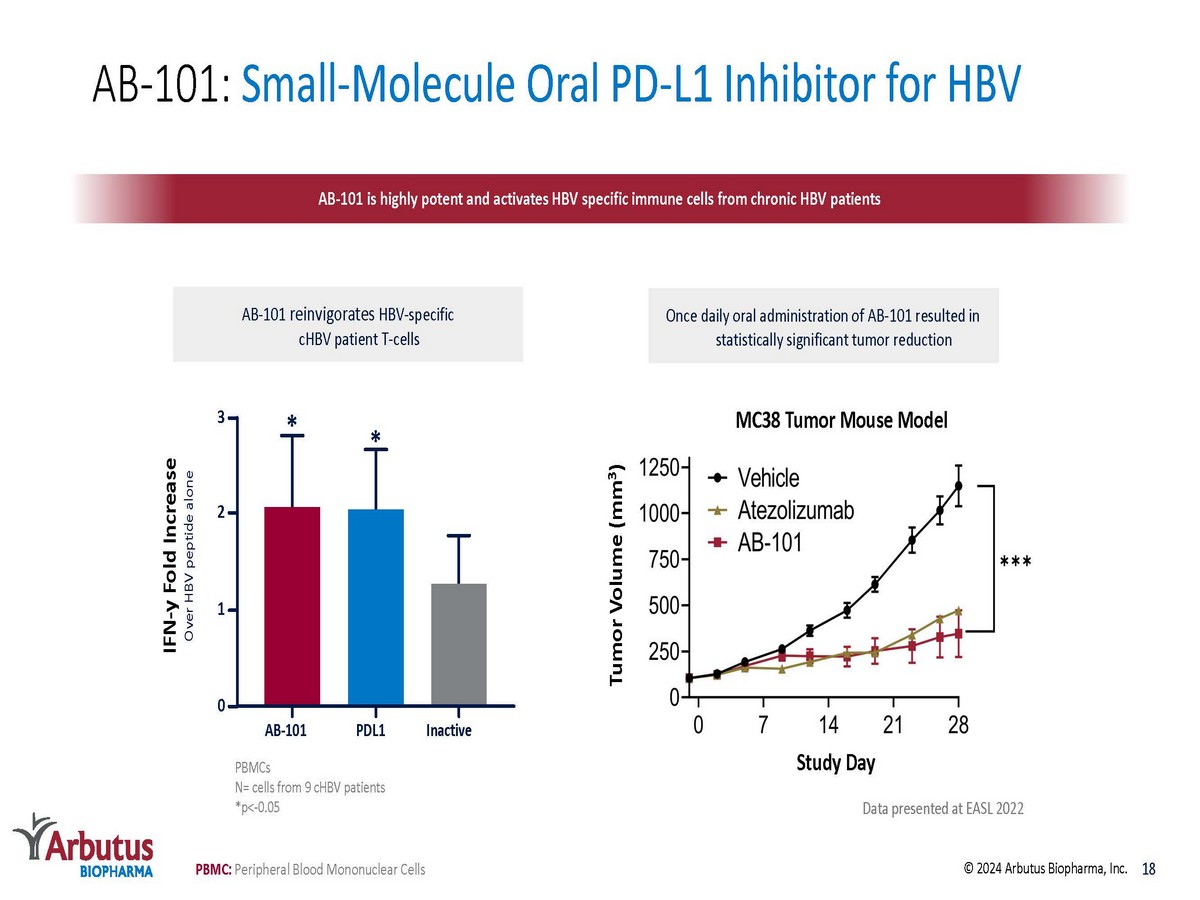
AB - 101: Small - Molecule Oral PD - L1 Inhibitor for HBV AB - 101 is highly potent and activates HBV specific immune cells from chronic HBV patients AB - 101 reinvigorates HBV - specific cHBV patient T - cells PBMCs N= cells from 9 cHBV patients *p< - 0.05 PBMC: P eripheral Blood Mononuclear Cells PDL1 * Inactive AB - 101 * 0 3 2 1 IFN - y Fold Increase Over HBV peptide alone 18 © 2024 Arbutus Biopharma, Inc. Once daily oral administration of AB - 101 resulted in statistically significant tumor reduction Study Day MC38 Tumor Mouse Model Tumor Volume (mm 3 ) Data presented at EASL 2022
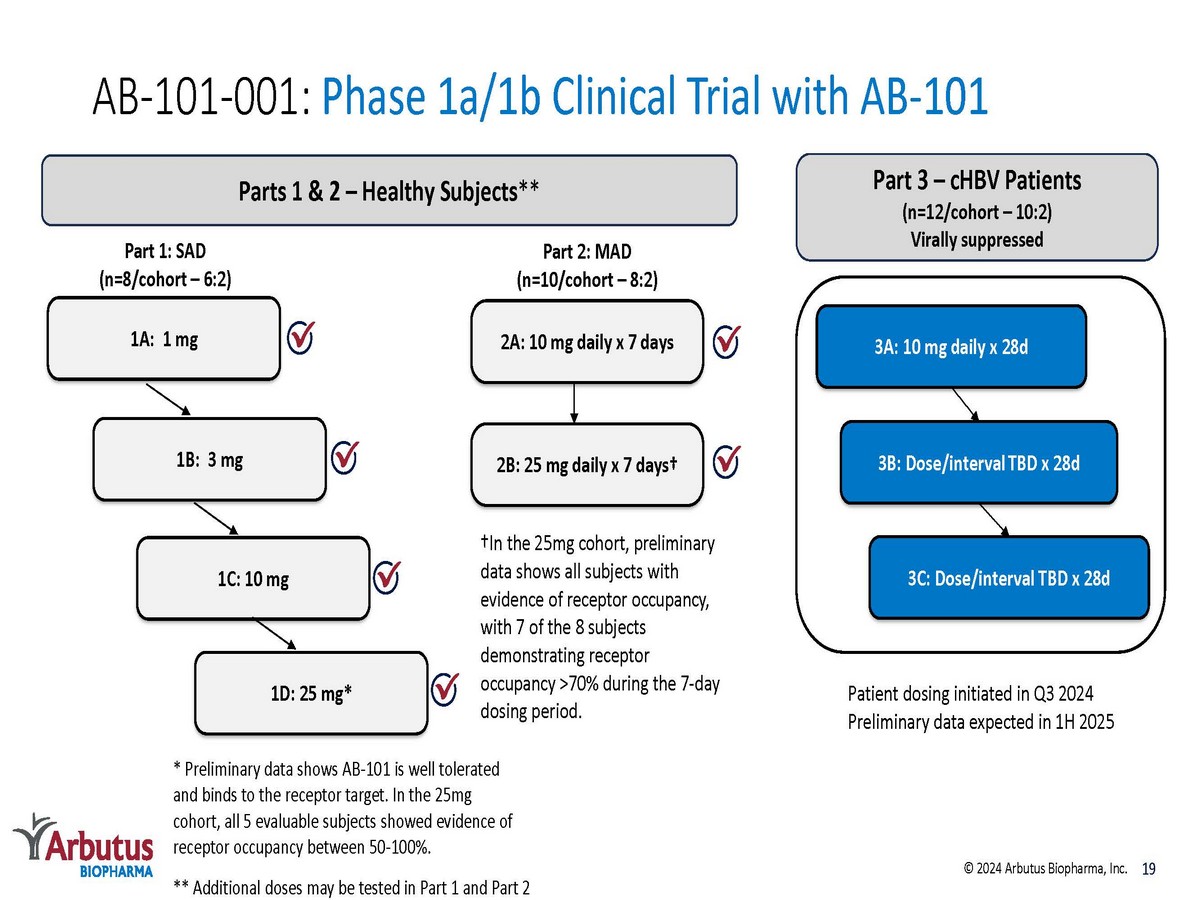
19 © 2024 Arbutus Biopharma, Inc. Part 1: SAD (n=8/cohort – 6:2) 1C: 10 mg 1B: 3 mg 1A: 1 mg Part 2: MAD (n=10/cohort – 8:2) 2A: 10 mg daily x 7 days 2B: 25 mg daily x 7 days† 3A: 10 mg daily x 28d 3B: Dose/interval TBD x 28d 3C: Dose/interval TBD x 28d AB - 101 - 001: Phase 1a/1b Clinical Trial with AB - 101 Parts 1 & 2 – Healthy Subjects ** Part 3 – cHBV Patients (n=12/cohort – 10:2) Virally suppressed ** Additional doses may be tested in Part 1 and Part 2 † In the 25mg cohort, preliminary data shows all subjects with evidence of receptor occupancy, with 7 of the 8 subjects demonstrating receptor occupancy >70% during the 7 - day dosing period. * Preliminary data shows AB - 101 is well tolerated and binds to the receptor target. In the 25mg cohort, all 5 evaluable subjects showed evidence of receptor occupancy between 50 - 100%. 1D: 25 mg * Patient dosing initiated in Q3 2024 Preliminary data expected in 1H 2025
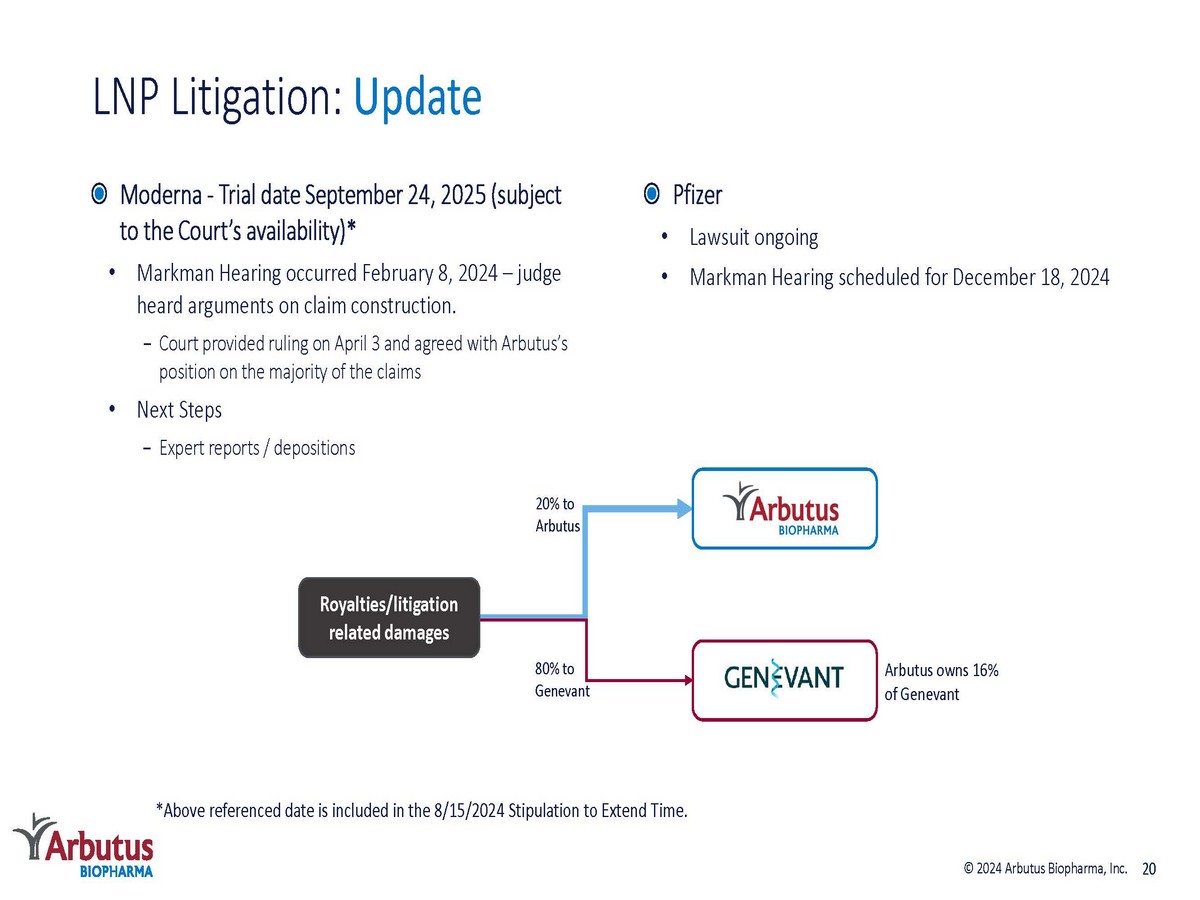
LNP Litigation: Update Moderna - Trial date September 24, 2025 (subject to the Court’s availability)* • Markman Hearing occurred February 8, 2024 – judge heard arguments on claim construction. – Court provided ruling on April 3 and agreed with Arbutus’s position on the majority of the claims • Next Steps – Expert reports / depositions 80% to Genevant Arbutus owns 16% of Genevant 20% to Arbutus Royalties/litigation related damages *Above referenced date is included in the 8/15/2024 Stipulation to Extend Time. Pfizer • Lawsuit ongoing • Markman Hearing scheduled for December 18, 2024 20 © 2024 Arbutus Biopharma, Inc.
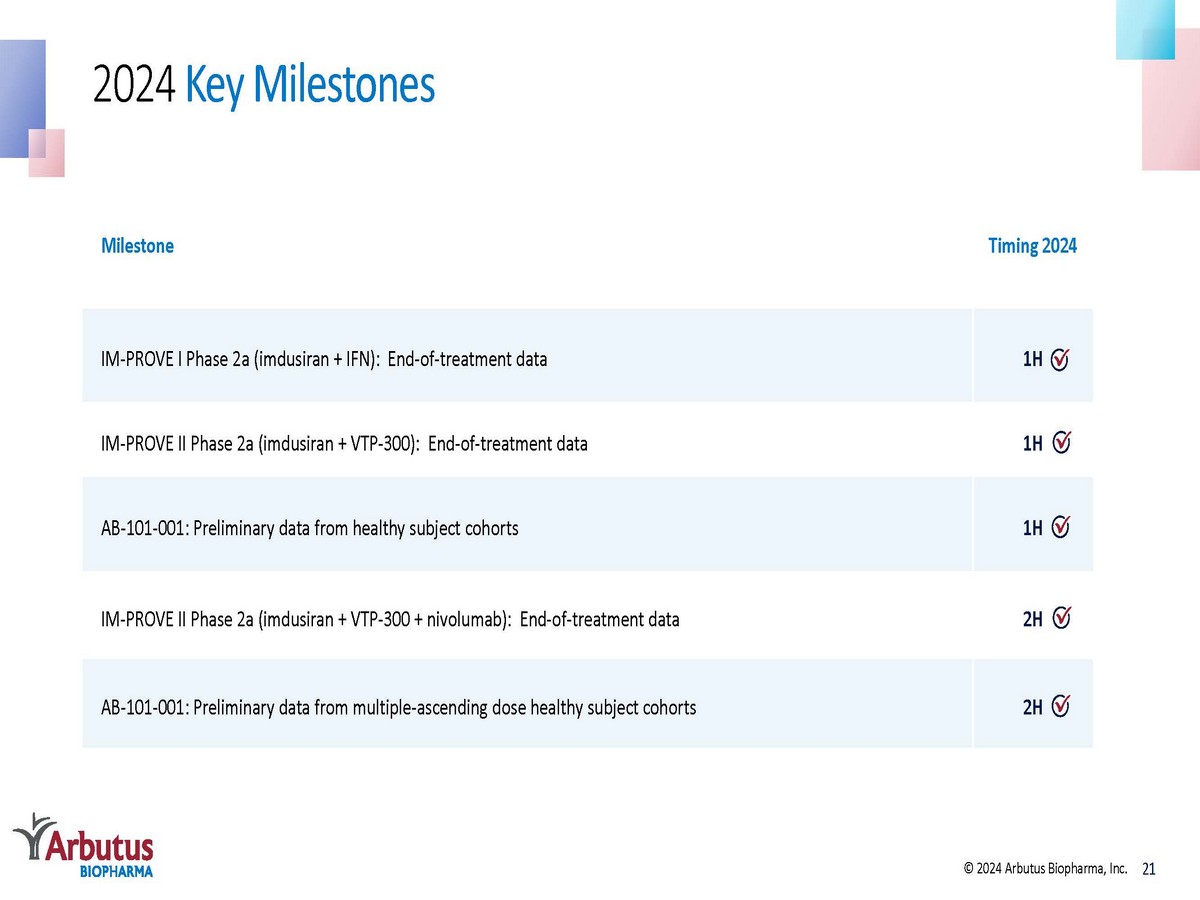
2024 Key Milestones 21 Timing 2024 Milestone 1H IM - PROVE I Phase 2a ( imdusiran + IFN): End - of - treatment data 1H IM - PROVE II Phase 2a ( imdusiran + VTP - 300): End - of - treatment data 1H AB - 101 - 001: Preliminary data from healthy subject cohorts 2H IM - PROVE II Phase 2a ( imdusiran + VTP - 300 + nivolumab): End - of - treatment data 2H AB - 101 - 001: Preliminary data from multiple - ascending dose healthy subject cohorts © 2024 Arbutus Biopharma, Inc.
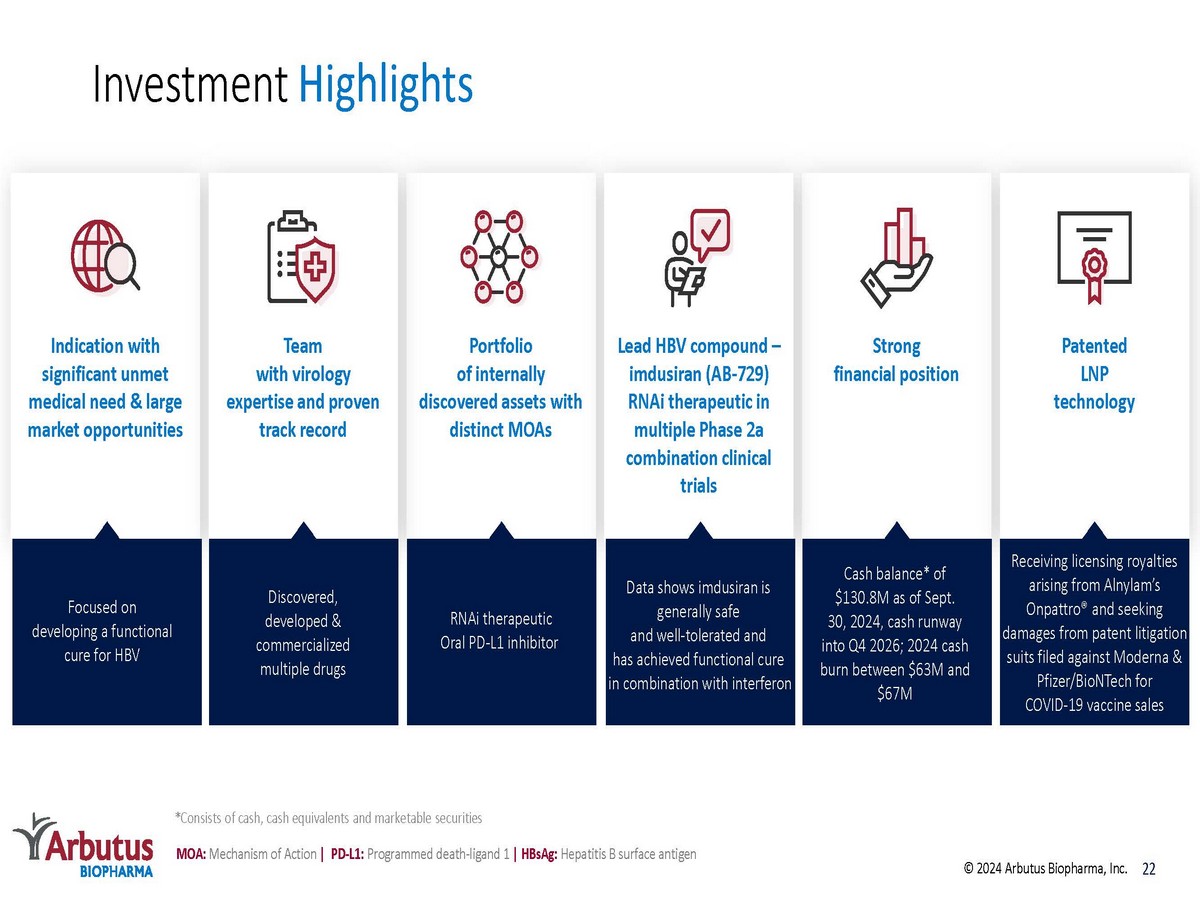
Investment Highlights Strong financial position Indication with significant unmet medical need & large market opportunities Patented LNP technology Portfolio of internally discovered assets with distinct MOAs Lead HBV compound – imdusiran (AB - 729) RNAi therapeutic in multiple Phase 2a combination clinical trials Team with virology expertise and proven track record Focused on developing a functional cure for HBV Cash balance* of $130.8M as of Sept. 30, 2024, cash runway into Q4 2026; 2024 cash burn between $63M and $67M Data shows imdusiran is generally safe and well - tolerated and has achieved functional cure in combination with interferon RNAi therapeutic Oral PD - L1 inhibitor Receiving licensing royalties arising from Alnylam’s Onpattro ® and seeking damages from patent litigation suits filed against Moderna & Pfizer/BioNTech for COVID - 19 vaccine sales Discovered, developed & commercialized multiple drugs MOA: Mechanism of Action | PD - L1: Programmed death - ligand 1 | HBsAg: Hepatitis B surface antigen 22 © 2024 Arbutus Biopharma, Inc. *Consists of cash, cash equivalents and marketable securities

Thank You 23 © 2024 Arbutus Biopharma, Inc.
v3.24.3
| X |
- DefinitionBoolean flag that is true when the XBRL content amends previously-filed or accepted submission.
| Name: |
dei_AmendmentFlag |
| Namespace Prefix: |
dei_ |
| Data Type: |
xbrli:booleanItemType |
| Balance Type: |
na |
| Period Type: |
duration |
|
| X |
- DefinitionFor the EDGAR submission types of Form 8-K: the date of the report, the date of the earliest event reported; for the EDGAR submission types of Form N-1A: the filing date; for all other submission types: the end of the reporting or transition period. The format of the date is YYYY-MM-DD.
| Name: |
dei_DocumentPeriodEndDate |
| Namespace Prefix: |
dei_ |
| Data Type: |
xbrli:dateItemType |
| Balance Type: |
na |
| Period Type: |
duration |
|
| X |
- DefinitionThe type of document being provided (such as 10-K, 10-Q, 485BPOS, etc). The document type is limited to the same value as the supporting SEC submission type, or the word 'Other'.
| Name: |
dei_DocumentType |
| Namespace Prefix: |
dei_ |
| Data Type: |
dei:submissionTypeItemType |
| Balance Type: |
na |
| Period Type: |
duration |
|
| X |
- DefinitionAddress Line 1 such as Attn, Building Name, Street Name
| Name: |
dei_EntityAddressAddressLine1 |
| Namespace Prefix: |
dei_ |
| Data Type: |
xbrli:normalizedStringItemType |
| Balance Type: |
na |
| Period Type: |
duration |
|
| X |
- Definition
+ References
+ Details
| Name: |
dei_EntityAddressCityOrTown |
| Namespace Prefix: |
dei_ |
| Data Type: |
xbrli:normalizedStringItemType |
| Balance Type: |
na |
| Period Type: |
duration |
|
| X |
- DefinitionCode for the postal or zip code
| Name: |
dei_EntityAddressPostalZipCode |
| Namespace Prefix: |
dei_ |
| Data Type: |
xbrli:normalizedStringItemType |
| Balance Type: |
na |
| Period Type: |
duration |
|
| X |
- DefinitionName of the state or province.
| Name: |
dei_EntityAddressStateOrProvince |
| Namespace Prefix: |
dei_ |
| Data Type: |
dei:stateOrProvinceItemType |
| Balance Type: |
na |
| Period Type: |
duration |
|
| X |
- DefinitionA unique 10-digit SEC-issued value to identify entities that have filed disclosures with the SEC. It is commonly abbreviated as CIK. Reference 1: http://www.xbrl.org/2003/role/presentationRef
-Publisher SEC
-Name Exchange Act
-Number 240
-Section 12
-Subsection b-2
| Name: |
dei_EntityCentralIndexKey |
| Namespace Prefix: |
dei_ |
| Data Type: |
dei:centralIndexKeyItemType |
| Balance Type: |
na |
| Period Type: |
duration |
|
| X |
- DefinitionIndicate if registrant meets the emerging growth company criteria. Reference 1: http://www.xbrl.org/2003/role/presentationRef
-Publisher SEC
-Name Exchange Act
-Number 240
-Section 12
-Subsection b-2
| Name: |
dei_EntityEmergingGrowthCompany |
| Namespace Prefix: |
dei_ |
| Data Type: |
xbrli:booleanItemType |
| Balance Type: |
na |
| Period Type: |
duration |
|
| X |
- DefinitionCommission file number. The field allows up to 17 characters. The prefix may contain 1-3 digits, the sequence number may contain 1-8 digits, the optional suffix may contain 1-4 characters, and the fields are separated with a hyphen.
| Name: |
dei_EntityFileNumber |
| Namespace Prefix: |
dei_ |
| Data Type: |
dei:fileNumberItemType |
| Balance Type: |
na |
| Period Type: |
duration |
|
| X |
- DefinitionTwo-character EDGAR code representing the state or country of incorporation.
| Name: |
dei_EntityIncorporationStateCountryCode |
| Namespace Prefix: |
dei_ |
| Data Type: |
dei:edgarStateCountryItemType |
| Balance Type: |
na |
| Period Type: |
duration |
|
| X |
- DefinitionThe exact name of the entity filing the report as specified in its charter, which is required by forms filed with the SEC. Reference 1: http://www.xbrl.org/2003/role/presentationRef
-Publisher SEC
-Name Exchange Act
-Number 240
-Section 12
-Subsection b-2
| Name: |
dei_EntityRegistrantName |
| Namespace Prefix: |
dei_ |
| Data Type: |
xbrli:normalizedStringItemType |
| Balance Type: |
na |
| Period Type: |
duration |
|
| X |
- DefinitionThe Tax Identification Number (TIN), also known as an Employer Identification Number (EIN), is a unique 9-digit value assigned by the IRS. Reference 1: http://www.xbrl.org/2003/role/presentationRef
-Publisher SEC
-Name Exchange Act
-Number 240
-Section 12
-Subsection b-2
| Name: |
dei_EntityTaxIdentificationNumber |
| Namespace Prefix: |
dei_ |
| Data Type: |
dei:employerIdItemType |
| Balance Type: |
na |
| Period Type: |
duration |
|
| X |
- DefinitionLocal phone number for entity.
| Name: |
dei_LocalPhoneNumber |
| Namespace Prefix: |
dei_ |
| Data Type: |
xbrli:normalizedStringItemType |
| Balance Type: |
na |
| Period Type: |
duration |
|
| X |
- DefinitionBoolean flag that is true when the Form 8-K filing is intended to satisfy the filing obligation of the registrant as pre-commencement communications pursuant to Rule 13e-4(c) under the Exchange Act. Reference 1: http://www.xbrl.org/2003/role/presentationRef
-Publisher SEC
-Name Exchange Act
-Number 240
-Section 13e
-Subsection 4c
| Name: |
dei_PreCommencementIssuerTenderOffer |
| Namespace Prefix: |
dei_ |
| Data Type: |
xbrli:booleanItemType |
| Balance Type: |
na |
| Period Type: |
duration |
|
| X |
- DefinitionBoolean flag that is true when the Form 8-K filing is intended to satisfy the filing obligation of the registrant as pre-commencement communications pursuant to Rule 14d-2(b) under the Exchange Act. Reference 1: http://www.xbrl.org/2003/role/presentationRef
-Publisher SEC
-Name Exchange Act
-Number 240
-Section 14d
-Subsection 2b
| Name: |
dei_PreCommencementTenderOffer |
| Namespace Prefix: |
dei_ |
| Data Type: |
xbrli:booleanItemType |
| Balance Type: |
na |
| Period Type: |
duration |
|
| X |
- DefinitionTitle of a 12(b) registered security. Reference 1: http://www.xbrl.org/2003/role/presentationRef
-Publisher SEC
-Name Exchange Act
-Number 240
-Section 12
-Subsection b
| Name: |
dei_Security12bTitle |
| Namespace Prefix: |
dei_ |
| Data Type: |
dei:securityTitleItemType |
| Balance Type: |
na |
| Period Type: |
duration |
|
| X |
- DefinitionName of the Exchange on which a security is registered. Reference 1: http://www.xbrl.org/2003/role/presentationRef
-Publisher SEC
-Name Exchange Act
-Number 240
-Section 12
-Subsection d1-1
| Name: |
dei_SecurityExchangeName |
| Namespace Prefix: |
dei_ |
| Data Type: |
dei:edgarExchangeCodeItemType |
| Balance Type: |
na |
| Period Type: |
duration |
|
| X |
- DefinitionBoolean flag that is true when the Form 8-K filing is intended to satisfy the filing obligation of the registrant as soliciting material pursuant to Rule 14a-12 under the Exchange Act. Reference 1: http://www.xbrl.org/2003/role/presentationRef
-Publisher SEC
-Name Exchange Act
-Section 14a
-Number 240
-Subsection 12
| Name: |
dei_SolicitingMaterial |
| Namespace Prefix: |
dei_ |
| Data Type: |
xbrli:booleanItemType |
| Balance Type: |
na |
| Period Type: |
duration |
|
| X |
- DefinitionTrading symbol of an instrument as listed on an exchange.
| Name: |
dei_TradingSymbol |
| Namespace Prefix: |
dei_ |
| Data Type: |
dei:tradingSymbolItemType |
| Balance Type: |
na |
| Period Type: |
duration |
|
| X |
- DefinitionBoolean flag that is true when the Form 8-K filing is intended to satisfy the filing obligation of the registrant as written communications pursuant to Rule 425 under the Securities Act. Reference 1: http://www.xbrl.org/2003/role/presentationRef
-Publisher SEC
-Name Securities Act
-Number 230
-Section 425
| Name: |
dei_WrittenCommunications |
| Namespace Prefix: |
dei_ |
| Data Type: |
xbrli:booleanItemType |
| Balance Type: |
na |
| Period Type: |
duration |
|
Arbutus Biopharma (NASDAQ:ABUS)
과거 데이터 주식 차트
부터 10월(10) 2024 으로 11월(11) 2024
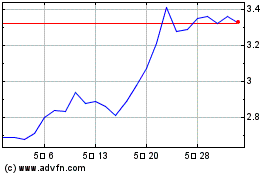
Arbutus Biopharma (NASDAQ:ABUS)
과거 데이터 주식 차트
부터 11월(11) 2023 으로 11월(11) 2024
